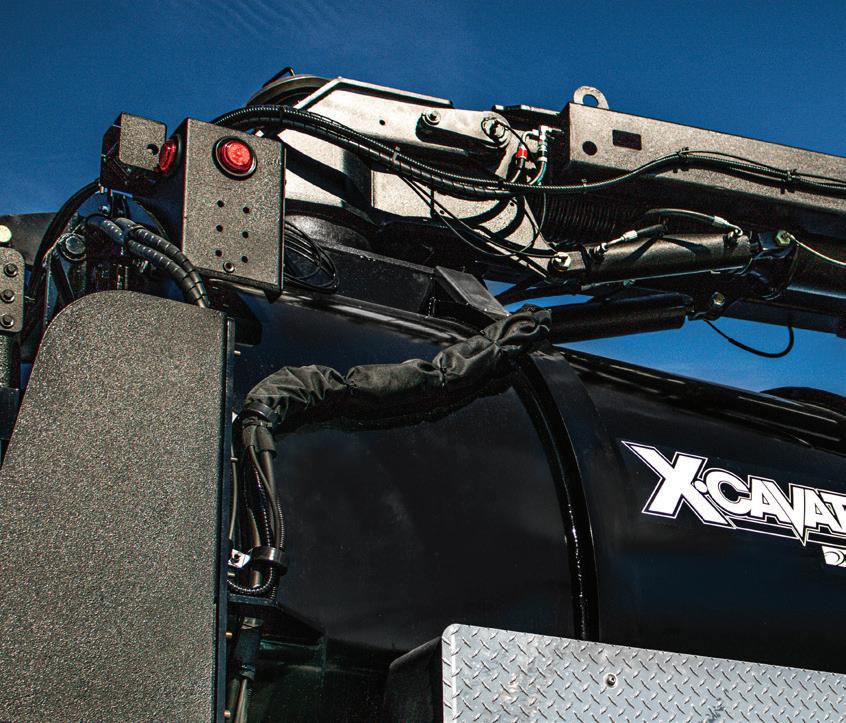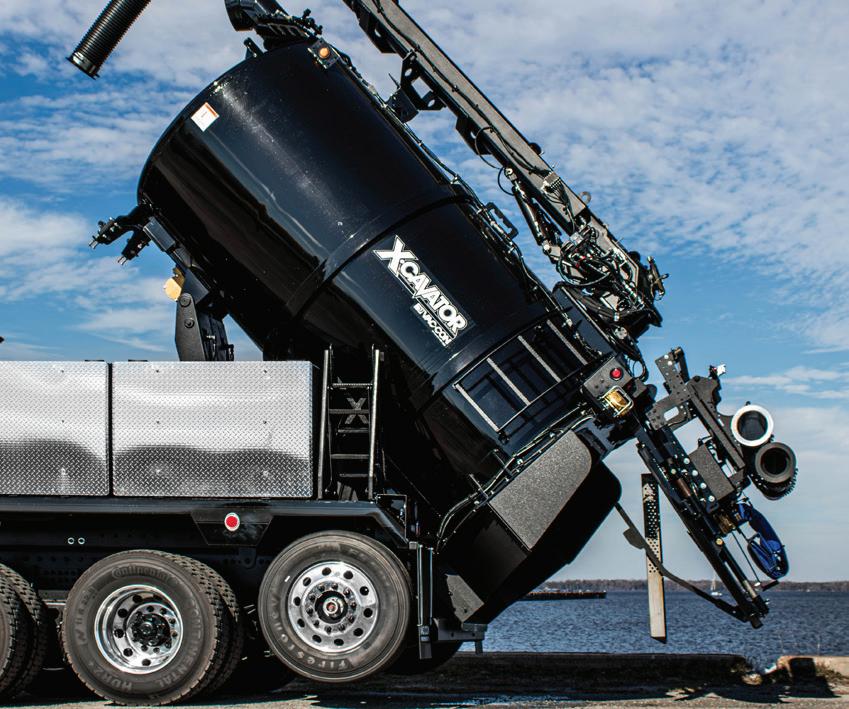


















House fires are faster and more toxic because of plastics, synthetics, lithium-ion batteries and other content
A house fire can become deadly in as little as two minutes. Here’s why: Today, homes are typically built of unprotected lightweight construction. They’re filled with products that burn fast and produce toxic smoke.
Home fire sprinklers are the only technology that can stop a fire from becoming deadly
That is why fire sprinklers are in national codes. Removing fire sprinklers from codes allows the construction of substandard, less safe homes. That puts residents, firefighters and communities at risk. Fire sprinklers can reduce construction costs
With installed fire sprinklers in an entire development, construction costs can be reduced. Incentives include increased hydrant spacing, street width reduction, waived fees, higher density and much more.







When a home is built without fire sprinklers, the true cost of a fire far outweighs sprinkler installation cost: injuries, death, property damage, displacement, responder exposure and impacts on municipal resources.
You can prevent substandard homes from being built in your community, protecting residents and firefighters.
For more information go to: homefiresprinkler.org/fire-sprinkler-informationfor-local-officials/



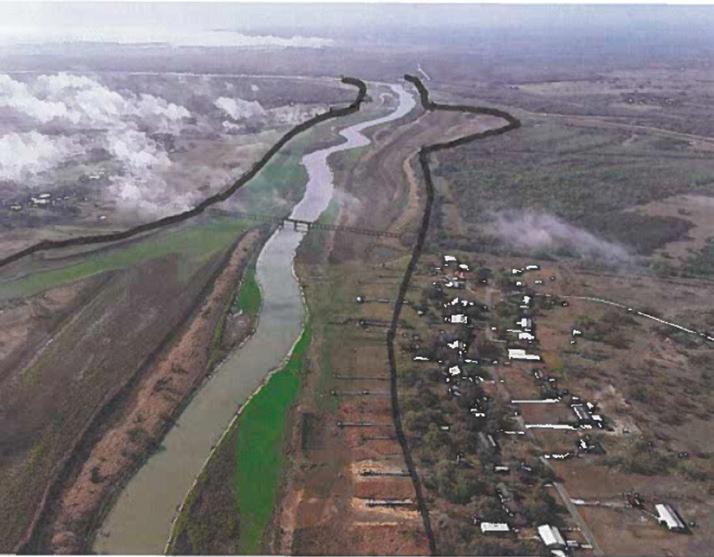
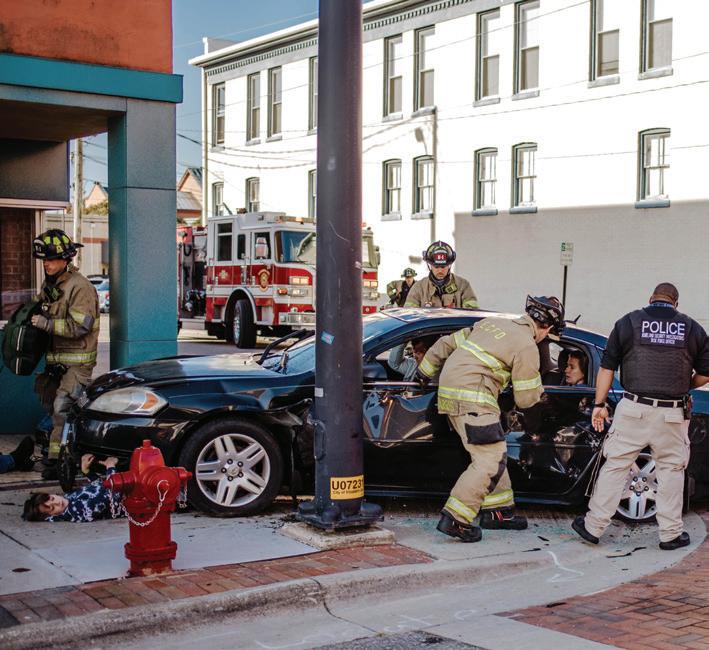
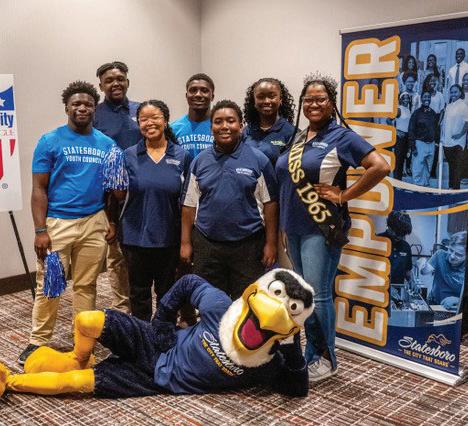
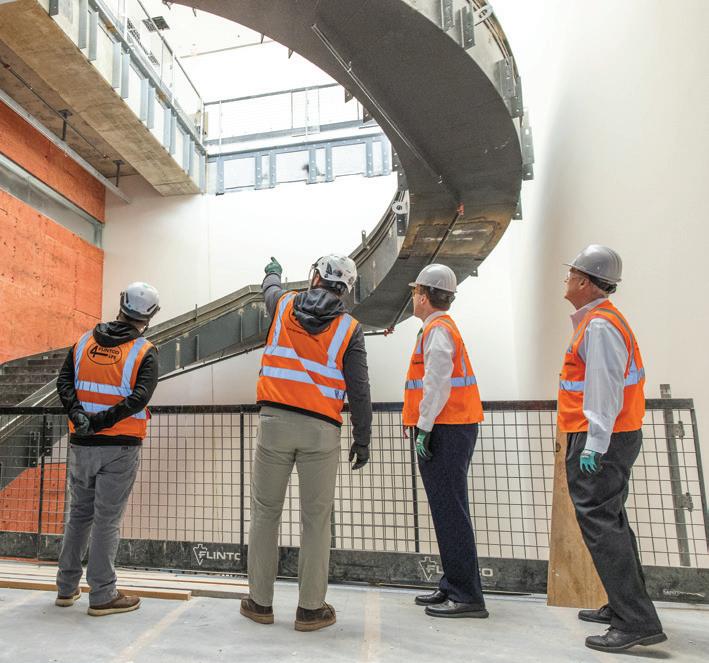

16 Crisis Management: When the water runs low: How two Texas towns are battling water scarcity
20 Crisis Management: Louisville, Colo., examining emergency management options 24 Crisis Management: Mass casualty exercise helps North Carolina agencies train for emergencies
Management: Be prepared: Community Emergency Response Team programs help citizens step up
36 Public Safety: Operation Cycle Break gets help to domestic violence victims and offenders
40 Streets, Highways & Bridges: Streetscape project revives Pennsylvania city’s historic beauty
44 Parks & Environmental Services: Statesboro youth push change forward
46 Fleet Services & Maintenance: Committed to change: Aspen, Colo., transitions to zero-emission fleet
48 Building & Construction: Gilcrease museum plans expanded home in Tulsa 52 Public Safety: Drone program boosts Lima police operations
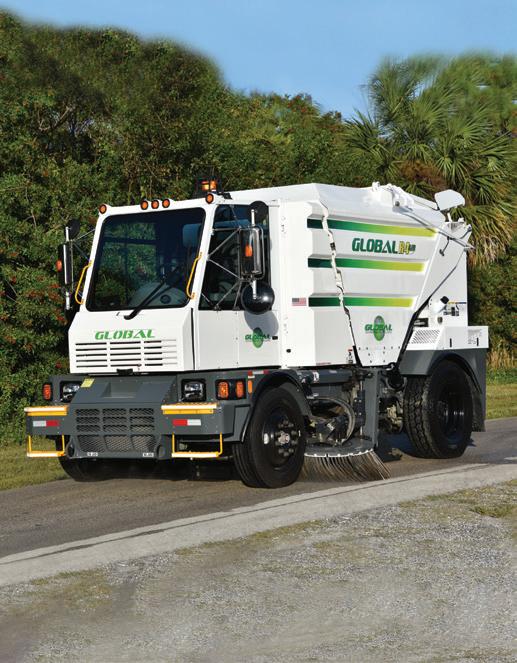


publisher RON BAUMGARTNER rbaumgartner@the-papers.com

editor-in-chief DEB PATTERSON dpatterson@the-papers.com
editor SARAH WRIGHT swright@the-papers.com

publication manager CHRIS SMITH chris@themunicipal.com
graphic designer MARY LESTER mlester@the-papers.com
business manager ANNETTE WEAVER aweaver@the-papers.com
mail manager KHOEUN KHOEUTH kkhoeuth@the-papers.com



director of sales and marketing KRISTIN DEVITTORIO kdevittorio@the-papers.com
marketing assistant REAGAN NICHOLS rnichols@the-papers.com
editorial assistant JODI MARLIN jodimarlin1241@gmail.com
Contributing Writers
Beth Anne Brink-Cox, Lauren Caggiano, Nicholette Carlson, Denise Fedorow, Danielle Lund, Janet G. Patterson, Julie Young
PO Box 188 • 206 S. Main St., Milford, IN 46542
866-580-1138/Fax 800–886–3796
Editorial Ext. 2307; Advertising Ext. 2505, 2408








Sarah Wright | Editor
As I began this editor’s note, an 8.8-magnitude earthquake shook Russia’s eastern coast, sparking tsunami alerts for countries on both sides of the Pacific. In the U.S., Hawaii, California and Washington braced for tsunami waves. Thankfully, the impact seems to be limited to water levels fluctuating and strong rip currents. It is a highlight of how chaotic the world can be. It is also an illustration that it is better to take precautions rather than be sorry, as was the case in Hawaii where evacuations occurred in coastal inundation zones.
2025 has been a year filled with reminders of nature’s might and unpredictability. My heart still hurts for Texas and the tragic loss of life in Kerr County from the floods. Texas has not been alone in grappling with flooding. As of Aug. 1, both New York City, New Jersey and Maryland are dealing with flooding, too, alongside North Carolina, which is still recovering from Hurricane Helene.
While containing many unknowns, weatherrelated disasters contain some predictability, with certain weather events being contained largely to set months. While variables differ
with each individual storm, municipal decision-makers can craft emergency management plans to prepare for various scenarios, saving lives and speeding any needed recovery efforts. These plans ensure everyone is on the same page and can also empower residents to prioritize their own safety.
Manmade emergencies follow no timetable and prove quite senseless, like the June shooting of firefighters doing their job in Coeur d’Alene, Idaho. Unfortunately, random acts of violence can shatter the security of any community. While we like to believe it could never happen in our own communities, there are no guarantees. Municipalities can only plan or train for the possibility.
That is exactly what local, county and regional partners did in Elizabeth City, N.C., with a mass casualty exercise. Planning for this event started in December 2023, almost a year before it took place on Oct. 19, 2024. Writer Nicholette Carlson details this exercise within this issue of The Municipal and how it came to be. It’s an excellent example of agencies working together to cultivate invaluable experience should the worst happen.
In this issue of The Municipal, we focus on how cities respond or prepare for emergencies.
Writer Danielle Lund spoke with Beeville, Texas, about its ongoing drought, which has it operating under Stage 3 of its drought contingency plan, the most severe level. She highlights the steps the community is taking to ensure water continues to reach its community of 13,000.
For communities dealing with flooding, the speedy removal of water-damaged items and debris is pivotal for community health and recovery. Douglas County, Ore., has used a voucher program to help residents remove such items. Our other emergency management-themed topics include Louisville, Colo.’s, partnership with the Boulder Office of Disaster Management for emergency management and how communities are using Community Emergency Response Team programs to empower residents during emergencies.
While it is impossible to be 100% prepared for an emergency, having a plan, reviewing that plan routinely and holding exercises can create a unified, improved response to them.


By SARAH WRIGHT | The Municipal
Global Environmental Products has long been at the forefront of innovation in the street sweeper industry, pioneering advancements in both fully electric and hybrid vehicle technologies. In January 2026, the company will further solidify its leadership with the launch of its latest development: an extended-range hybrid electric street sweeper engineered to bridge the gap between conventional internal combustion models and full battery-electric platforms.
This next-generation sweeper presents municipalities with a cost-effective entry point into electric vehicle adoption providing measurable fuel and maintenance savings while requiring significantly less infrastructure investment. Designed with both performance and practicality in mind, the platform is optimized for municipalities where traditional electric sweepers remain financially or operationally out of reach.
“We’ve engineered high-capacity sweepers with large battery systems in the past,” explained Sebastian Mentelski, Director at Global Environmental Products. “However, these systems come at a premium especially for agencies without access to state or federal funding. For many smaller municipalities, the capital costs of a fully electric fleet can be prohibitive.”
Recognizing the need for scalable electrification, Global’s new extended-range hybrid platform delivers the environmental and operational benefits of an electric drive system without the high up-front costs typically associated with full electrification. Unlike standard EV or hybrid sweepers, this model incorporates a compact battery pack, enabling overnight charging and electriconly sweeping for approximately 2.5 hours per cycle.
“When the battery depletes to about 20% state of charge, the onboard engine seamlessly engages and recharges the battery in roughly 45 minutes,” Mentelski explained. “Once recharged, the engine disengages, and the unit resumes electric operation—automatically, without any operator input.”
This intelligent hybrid configuration maintains the performance standards of a fully electric sweeper while reducing daily fuel consumption from an estimated 38-45 gallons to just 5-7 gallons per hour. The system enables full-shift operation even in the event of missed charging while delivering the clean energy benefits and public goodwill associated with electrified municipal fleets. With significantly lower capital costs than traditional EV sweepers, the extended-range hybrid offers a compelling return on investment. “For most customers, factoring in fuel and maintenance savings, the breakeven point occurs around the seven-year mark,” Mentelski noted. “Beyond that, operators continue to benefit from reduced operational expenditures for years.”
By relying on electric propulsion for a portion of daily operation, the hybrid system


The M4PHEV Extended Range system allows for operating the sweeper continuously. There is no need to park the sweeper to recharge the batteries. The on-board charging system allows for sweeping in colder climates, while operators can sweep through multiple shifts.
also reduces mechanical strain on the engine, translating to reduced maintenance needs and extended component life. Additionally, it removes the barrier of costly charging infrastructure; while full EV sweepers may require $150,000-plus DC fast charging stations, the plug-in hybrid charges on standard overnight systems and can continue operating even if charging was not performed.
The hybrid model is particularly wellsuited for colder climates, where concerns about range degradation can be pronounced. The inclusion of a combustion engine as a supplementary power source eliminates range anxiety and ensures operational continuity, regardless of weather or charging habits.
“If a user forgets to plug it in overnight, it’s not a crisis,” Mentelski said. “The unit will
simply operate longer in charging mode and continue the shift.”
Global Environmental currently has two pre-production models undergoing field testing, with full-scale production scheduled to begin in 2026. Once available, this hybrid model will complement Global’s existing diesel and fully electric product lines offering customers a versatile, middle-ground solution that balances sustainability, affordability and reliability.
“We’re proud to give municipalities three solid options for their fleet needs,” Mentelski said. “They can choose a traditional diesel unit, a fully electric model or this new extended-range plug-in hybrid.”
For more information on the upcoming release and other innovations, visit www.globalsweeper.com.

By JULIE YOUNG | The Municipal
It was a genre-bending film that coupled romance with the science fiction concept of time travel. Playwright Richard Collier, played by the late Christopher Reeve, becomes enamored with a photo of Edwardian-era actress Elise McKenna, played by Jane Seymour, and through self-hypnosis travels back to 1912 to win over the woman of his dreams.
Based on the book “Bid Time Return” by Richard Matheson, the 1980 movie is a cult classic that was filmed on location in Mackinac Island, Mich., and has had fans flocking to the ferry boats ever since in search of the places associated with the beloved movie. However, what they find is so much more.
Situated on Lake Huron between Michigan’s upper and lower peninsulas, Mackinac Island is unlike any other place in the U.S. Although the island has most of the modern creature comforts people expect from resort
ABOVE: The Grand Hotel on Mackinac Island, Mich., has been the setting for 1947’s “This Time for Keeps,” starring Esther Williams, as well as the 1980 cult classic “Somewhere in Time,” starring Jane Seymore and Christopher Reeve. (Photos by Julie Young)
destinations, it is notable for its 1901 ban on motor vehicles, which gives the island its unique atmosphere. Residents — 583 in 2020 — and visitors alike navigate the island’s 4.35 square miles on foot, via horse-drawn taxi or by riding bicycles. Mackinac Island is also dappled with Victorian architecture, which makes it the perfect place for filming period pieces.
Central to the “Somewhere in Time” story line is the Grand Hotel, which opened its doors in 1887 and has become a National Historic Landmark that continues to captivate visitors with its old-world hospitality and charm. Guests and visitors can climb the red staircase to enjoy the view from the world’s largest front porch; linger in the parlor; grab a bite

Rock
to eat at the Geranium Bar or at Sadie’s Ice Cream Parlor; take part in afternoon tea; or enjoy dinner in the main dining room, where upscale attire is required.
Visitors and guests can also tour the hotel’s hall of history, where there are photos of notable visitors to the grounds as well as mementoes from movies that were filmed on site. The hotel has Christopher Reeve’s bowler hat, room key and the watch that his character carried, along with the music box and bench that were featured in the film. The seat in which Reeve sat to watch Seymour deliver her soliloquy on love is in the hotel’s theater.
The Grand Hotel was also the setting for the 1947 movie “This Time for Keeps,” starring Esther Williams. The hotel has several images and props from that film as well, including the hotel swimming pool, which was named in Ms. Williams’ honor.
Just north of the boardwalk, along M-185 and on the water’s edge is the “Is it you?” tree where Seymour’s character meets Reeve’s character for the first time; and the movie’s gazebo can be found at Fort Mackinac near Anne’s Tablet.
Can’t get enough? Then join the Grand Hotel for its “Somewhere in Time” weekend in early October, where guests can take in a screening of the film and participate in other themed events. Seymour herself is often present throughout the weekend, wearing period gowns and chatting with guests.
Looking for more than romantic locations? Fort Mackinac is sure to be the highlight of military buffs’ visit. Fort Mackinac served as a miliary outpost first for the British and later, American soldiers from 1780 to 1895. The campus includes the oldest building in Michigan as well as 13 other structures that highlight a century of military life.
Admission includes a self-guided tour of the fort’s buildings, as well as entrance to the Richard and Jane Manoogian Mackinac Art Museum; Biddle House, featuring the Mackinac Island Native American Museum; the Benjamin Blacksmith Shop; and more. Insider tip: The Soldier’s Barracks and Post Commissary are a great place to start a tour and get

The “Is it you?” tree is located just north of the boardwalk on M-185. This is the spot where actress Elise McKenna meets playwright Richard Collier in the 1980 movie “Somewhere in Time.”

Main Street on Mackinac Island is home to a number of cute shops, fudge factories, bike liveries, hotels and restaurants.
oriented with the layout of the campus, but don’t miss out on a stop by the Tea Room Restaurant, which offers a stunning view of the island village and the shimmering waters offshore. Best of all, the Tea Room is operated by the Grand Hotel and boasts a menu that has something for everyone.
Jodie Herrin of Jacksonville, Fla., took a nap in her hotel room as her husband and son toured Fort Mackinac, but after seeing their photos, she wished she would have accompanied them on their adventure, she said.
“The view from the top of the Fort was amazing. While they were there, they got to see a reenactment of parade marching and rifle firing like it was done during the war.”
Victoria Biddle of Belmont, N.C., said visiting Mackinac Island was like a dream come true.
“The whole island was like a time capsule, and we were happy to escape the chaos of modern life.”
We used Air Burners® to dispose of thousands of tons of debris after Hurricane Harvey. Instead of piles of waste taking up space for months, we cleanly reduced it to a small pile of ash with very little smoke. An efficient, low-impact solution for large-scale disaster cleanup.
Texas Fireman
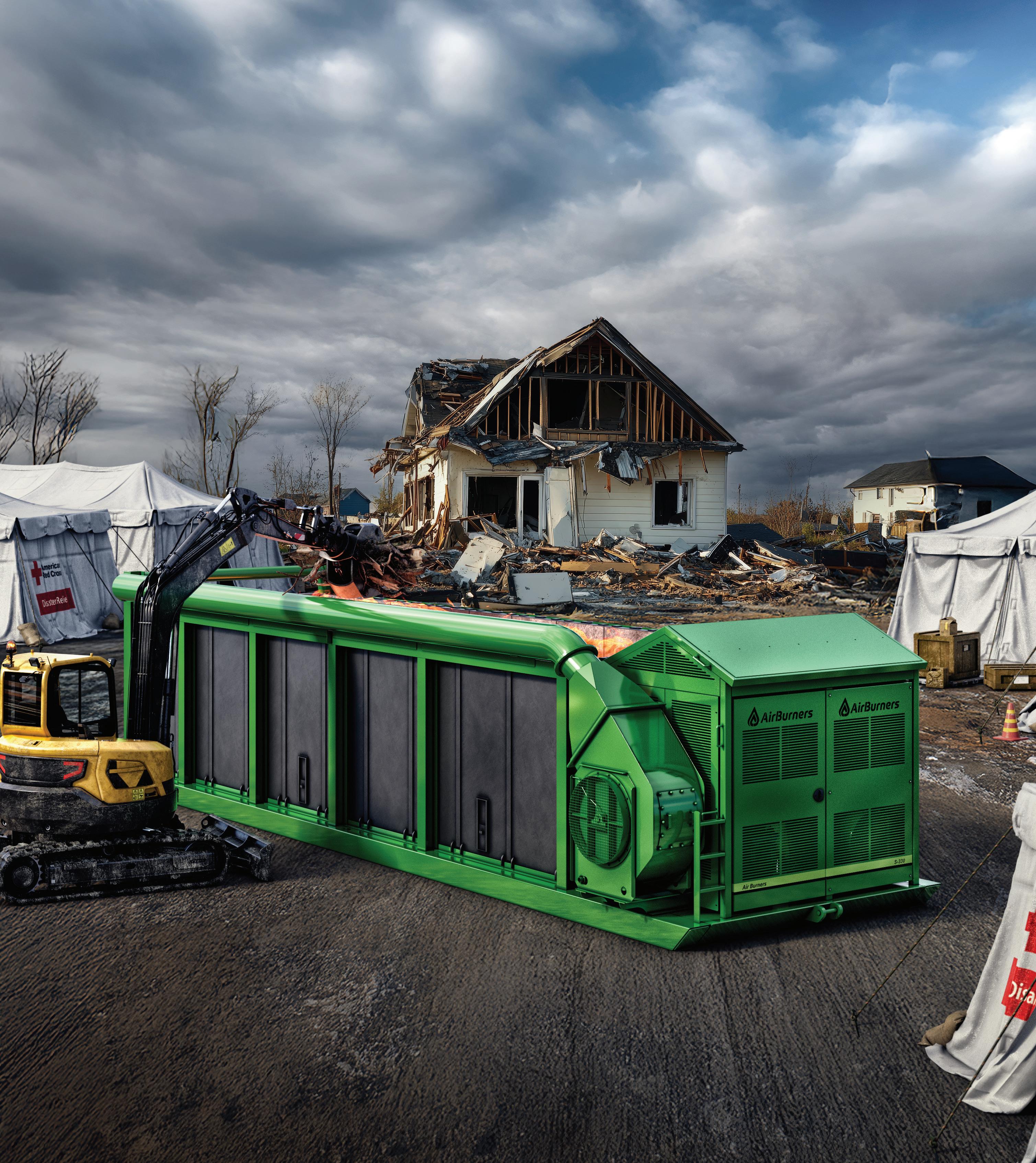
When disaster strikes, cleanup can’t wait.
After hurricanes and wildfires, Air Burners FireBoxes help crews eliminate thousands of tons of wood waste—quickly, cleanly, and with minimal smoke. No grinding. No hauling. Just efficient volume reduction on-site, with a small pile of ash left behind. It’s a solution trusted at the highest levels—FEMA has put our machines to the test and cleared them for disaster cleanup across the country.
“
30%

In Texas, Lake Corpus Christi is under 30% capacity as of mid-2025. As Beeville, Texas’, main water source, the city has been operating under Stage 3 of its drought contingency plan, which is the most severe level.

400,000
New York Gov. Kathy Hochul announced that over 400,000 New Yorkers have participated in a Citizen Preparedness Corps program over the past 10 years.

$214,000
Louisville, Colo., received a proposal from Boulder Office of Disaster Management with an early cost estimate of $214,000 for coverage. The figure would cover the addition of a new staff person to Boulder ODM.

60+
Over 60 community members, 10 public safety agencies, Sentara Albemarle Medical Center and Towne South Church participated in a mass casualty training in Elizabeth City, N.C.

60 miles
An EF-4 tornado that hit London, Ky., in June stayed on the ground for nearly 60 miles. Peak wind speeds hit 170 mph. At its widest, the monster tornado was 1,700 yards wide. Around 2,000 volunteers spent 11,000 hours helping the community recover.
850 acres

One night in June, wind whipped the Banana Lake fire in western Montana to 850 acres. This early start to the state’s fire season was met with 194 firefighters, two helicopters, 14 engines and 10 water trucks as crews established containment lines around portions of the fire.
Source: https://www.kpax.com/news/firewatch/ fire-managers-discuss-banana-lake-fire-burning-near-plains.

Source: https://www.whas11.com/article/weather/london-kentucky-tornado-pathnws/417-f32e93b2-e830-4728-a02e-46dfba2e3150.
1965
The state of Minnesota first used its siren system in 1965, and since then, it has been used almost exclusively for tornadic danger. Officials are considering how to best utilize all types of local warning systems to alert the public to other potentially deadly events like wildfires or floods.

Source: https://www.startribune.com/after-deadly-texas-floods-minnesota-officialssay-they-are-attuned-to-how-bad-things-can-get/601394252.
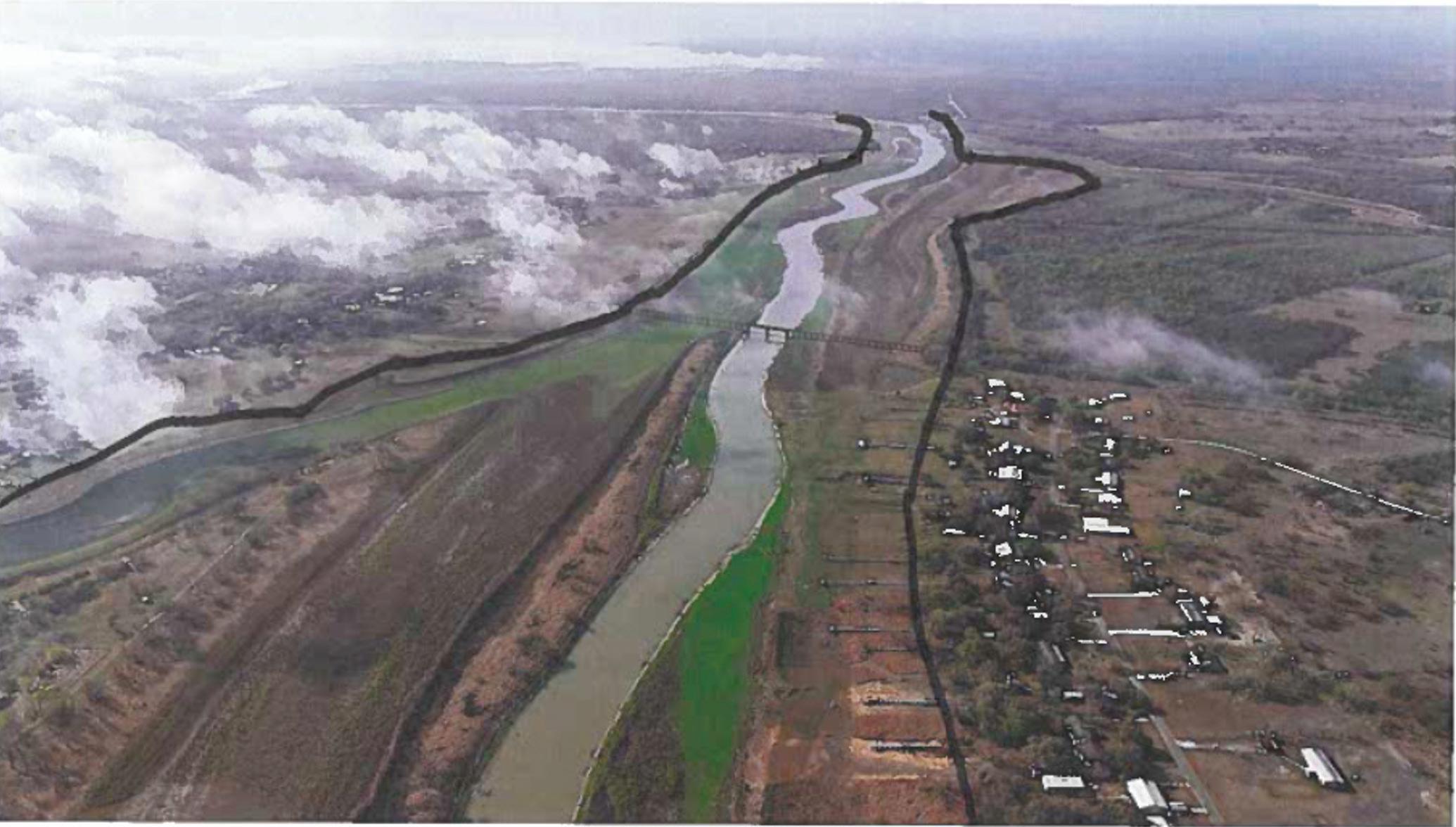
By DANIELLE LUND | The Municipal
Across Texas, water scarcity is no longer a distant environmental concern. It’s now a reality already reshaping how communities live, plan and survive. In 2025, Texan cities like Beeville and San Marcos are navigating distinct, but connected, water challenges, ranging from drought-driven infrastructure failures to long-term population pressures. Both municipalities are taking urgent steps to address the present crisis while preparing for an increasingly dry future.
In February, residents of Beeville experienced the unthinkable, as the water flowing from their taps suddenly stopped. For a community of 13,000 people in Bee County, this wasn’t just an inconvenience, but an existential shock into action.
“The problem started when a leak was found on our raw water line that provides
water from Lake Corpus Christi to our water treatment plant,” said Beeville City Manager John Benson. What began as a single breach quickly spiraled into widespread outages. At one point, bottled water had to be distributed, and a boil water notice was issued.
But the broken pipe was only part of the story. Beneath the surface, literally and
ABOVE: The area marked in black highlights the lake levels from 2019, clearly showing how much the lake has diminished over the years. (Photo provided by Beeville, Texas)
figuratively, a deeper threat was emerging: the slow collapse of Beeville’s primary water source.
“Lake Corpus Christi is our main water source,” Benson explained. “But the lake level has been declining steadily over the past few years. By late last year, it dropped to a point where our intake structure wasn’t even in the lake anymore. It’s now only within the boundaries of the lake because the water has receded so far.”
As of mid-2025, the lake hovers at under 30% capacity. “We’re now totally dependent on the Nueces River itself,” Benson said.
“We’ve had divers out at the intake structure regularly over the last six weeks. The water is hovering around just 8 feet above our lowest intake point. That’s incredibly low, and we know the pumps will start failing at some point. We’re just trying to figure out when.”
To answer that question and chart a path forward, Beeville has partnered with Garver Engineering to conduct a system-wide evaluation. In the meantime, the city is operating under Stage 3 of its drought contingency plan, which is the most severe level. That means mandatory restrictions for the community, such as no lawn watering, no washing cars with running water, no watering driveways or foundations or anything else that requires excessive water usage.
“It’s about conserving every drop we can at this point,” Benson said.
But Beeville isn’t just relying on restrictions. The city is pursuing a bold two-phase plan to pivot from surface water to groundwater. The first phase involves rehabilitating two previously capped wells and drilling two more. However, the water from these deep aquifers is brackish and requires reverse osmosis before it’s safe for consumption. That means portable treatment units, or “reverse osmosis on skids,” as Benson said, will be deployed to process water on-site at the wells for an immediate solution.
In the long term, these skids will be relocated to a centralized treatment facility, connected by a new conveyance system. One of the biggest concerns for the city at this time is the financing, as the entire project is slated to cost about $30 million.
“Funding is a huge question,” Benson acknowledged. “The state of Texas has done a good job of making resources available more than a billion dollars a year and the EPA has programs, too, but those are harder to access. In the meantime, we’re looking at bonds and other financing options.”
Amid this planning, Beeville is confronting immediate quality concerns as well. With lake levels so low, organic materials are more concentrated in the remaining water, leading to discoloration and increased customer complaints. “We’re still treating the water, but people are still, understandably, concerned,” Benson said.
To keep the community informed and engaged, Beeville has doubled down on transparency. The city maintains a public

Lake Corpus Christi is an artificial lake, which serves as a regional water source to multiple communities in approximately seven area counties, including Bee County, where the city of Beeville is located. (Photo provided by Beeville, Texas)

website, beevillewater.com, to share updates, conservation tips and plans for improvement. It is also working with the local school district on an awareness campaign called “A Day Without Water,” designed to educate students about the importance of water and what it means to live without it.
“Raising awareness, reducing demand, rethinking water,” Benson said. “That’s what we’re trying to do at this time.”
While Beeville scrambles to keep water flowing today, another Texas city, San
Lake Corpus Christi is currently experiencing some of the lowest levels ever recorded with no hope of natural restoration in sight. (Photo provided by Beeville, Texas)
Marcos, is looking toward tomorrow. This city of over 70,000 has not yet experienced widespread outages, but the writing is on the wall. Drought, coupled with rapid population growth, is placing an unsustainable strain on water resources like the San Marcos River and the Edwards Aquifer.
To respond, city leaders have also activated their drought contingency plan and imposed outdoor watering restrictions. But they’re also taking a long-term view by pushing
for sustainable building codes, smart meters and investment in water reuse infrastructure.
San Marcos is embracing innovation, from rebates on low-flow appliances to exploring alternative sources like aquifer storage and recovery. Data and modeling tools are helping the city better understand consumption trends, while regional collaboration ensures that planning isn’t done in isolation.
The stories of Beeville and San Marcos represent two sides of the same challenge. One community was jolted into action by a sudden failure; the other is acting to prevent that day from happening. Both cities help to show how fragile the water supply has become in parts of Texas and how resourceful local governments must be to meet that challenge.
Beeville’s rapid switch to groundwater, though expensive, is an example of decisive local leadership under pressure. San Marcos’s emphasis on planning, technology and policy reform shows how proactive approaches can insulate a city from crisis.
Water scarcity in Texas is no longer hypothetical. It’s here and actively causing concerns. The question now is whether communities can build the infrastructure, obtain funding and draw public support to meet the moment. If they do, it won’t just be about surviving drought, but it will be about transforming how we live in an era of water scarcity.



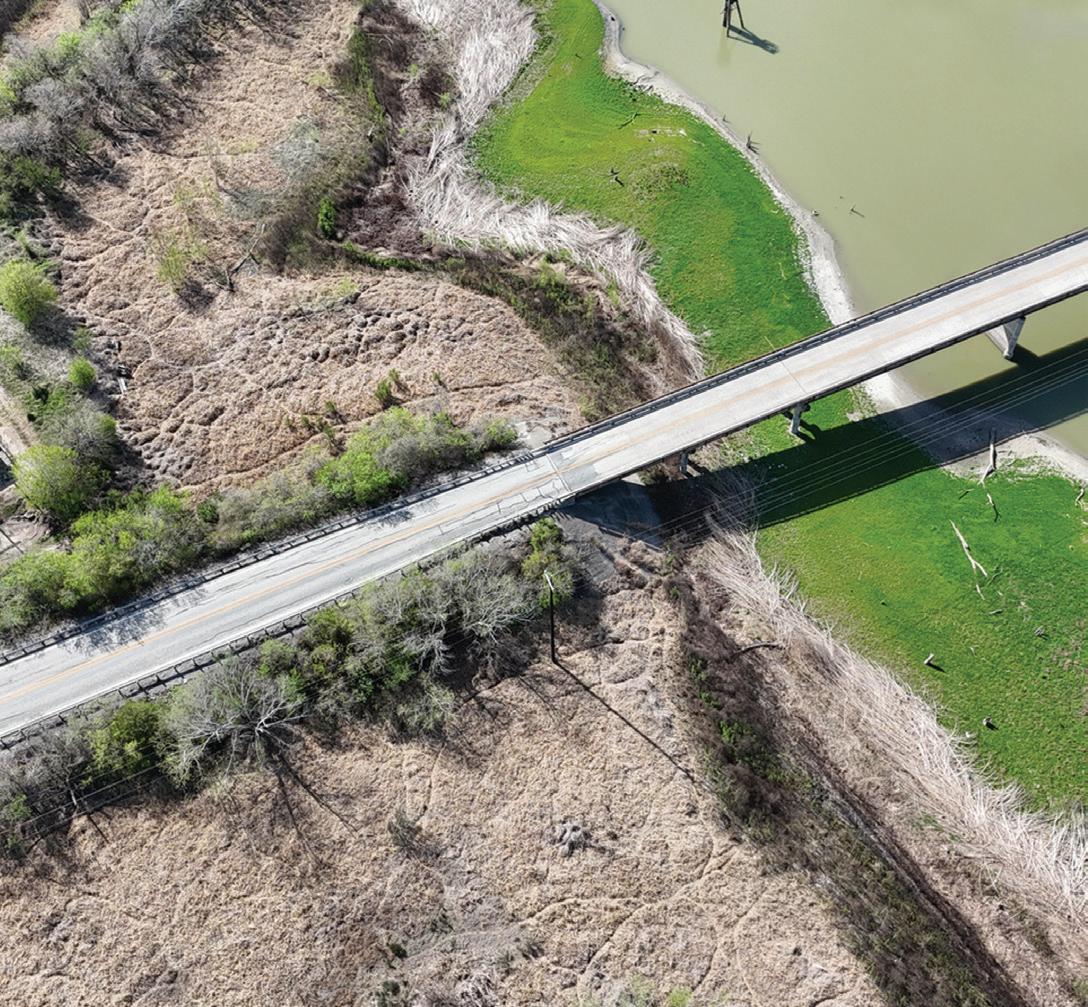








By DENISE FEDOROW | The Municipal
Louisville, Colo., City Manager Diana Langley has been on the job since March 2025 and recognized that the city has experienced quite a few natural disaster events, but didn’t have a comprehensive plan how to deal with them.
Prior to coming to Louisville, Langley worked for the city of Yuba City, Calif., for 29 years, the last four and a half years as city manager. Langley said Louisville is a smaller city both in the agency’s size and in population, with a population of about 20,000. The city has experienced quite a few emergency disasters. It went through a flood event in 2012, a large
hail event in 2019 and then the Marshall Fire on Dec. 30, 2021, which impacted a large portion of Louisville.
Based on that and the fact that Louisville doesn’t have its own fire department fire and EMS services are provided by Louisville Fire Protection District she felt partnering
ABOVE: Pictured is the Louisville, Colo., City Hall. (Photo provided by Louisville, Colo.)
with the Boulder Office of Disaster Management might be best.
“This is Boulder ODM’s full-time job. They have dedicated staff providing emergency preparedness and disaster management for the county and the city of Boulder (so) to be able to have those resources, that will help keep us up on emergency operations plan, continuity of operations plan, and also up to date on training and getting information out to our residents. Being able to tap into those services and the expertise they have, just

from a cost perspective, it’s cost effective to make sure we’re all prepared and that we’re providing the best services to our residents; it seems like the best option,” she said.
A decision has not yet officially been made, but the council and residents have shown support for the idea.
Langley shared that she had just received a proposal from Boulder ODM with an early cost estimate of $214,000, which will cover the addition of a new staff person to Boulder ODM. She said the additional staff person wouldn’t be exclusive to Louisville; the municipality would have access to all the staff and resources of the organization. She said Louisville will cover that cost within the city’s budget, without any grants.
“We are going through the mid-year budget process, and I updated our financial model to include the $214,000 for joining ODM,” Langley reported.
She said having Louisville join Boulder ODM will be cost neutral to Boulder County and the city of Boulder, “which was important to the Boulder board.”
At first, officials planned to hire a consultant to prepare an emergency disaster plan for the city. “I wasn’t sure how long it would take to join Boulder,” she explained.
But then she heard that Boulder ODM is updating its policy, “So it just makes sense to create an annex to that EOP for Louisville, saving us money on separate consultant costs.”
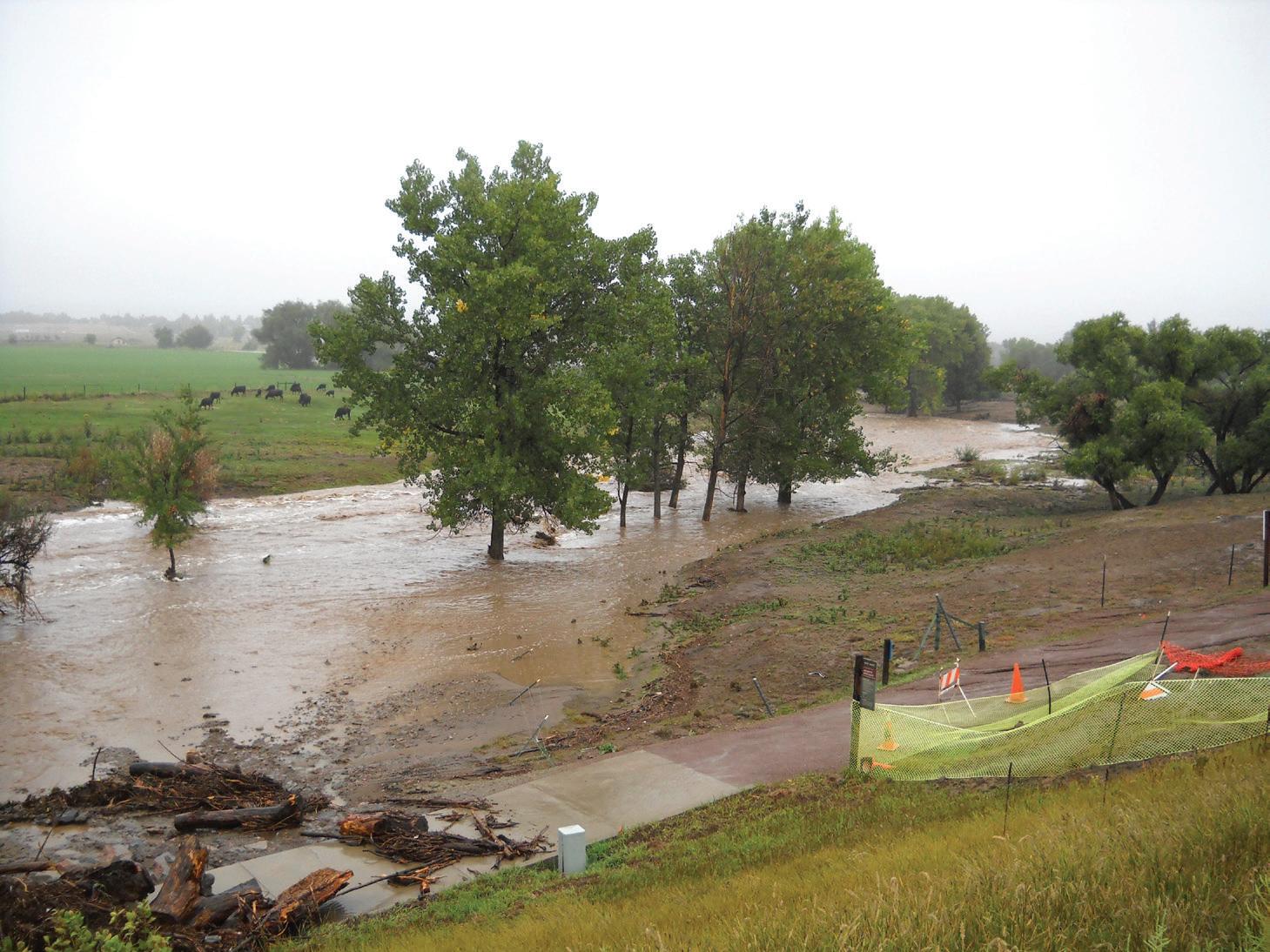
Langley doesn’t feel Louisville has a lead in emergency situations. Typically, a city’s fire department is the driving force behind all emergencies, and Boulder ODM would be that lead. She said that while Louisville Fire Protection District covers all of the city of Louisville and they are a full-time operation it is separate from the city and is funded through property taxes. The district has its own board and doesn’t attend city council meetings. Langley said her goal is to strengthen the partnership between the city and the Louisville Fire Protection District and improve communication so there’s not that separation. She hopes that Boulder ODM can “be the bridge to coordinate between the city and the fire protection district so we can strengthen that partnership.”
She said residents don’t care where the aid comes from as long as it comes.
The Boulder Office of Disaster Management would encompass all disasters and would offer resources to help Louisville keep up on its emergency operations plan, continuation of operations, keep them up to date on awareness and preparedness trainings and help with getting information out to residents.
She said the city would participate in programs and events it would hold for the public. She said that if there were an emergency, as a partner of their emergency operations center, Boulder ODM would be the lead in implementing the plans and in structuring the emergency.
Boulder ODM would also train the staff, something that has been lacking since Louisville doesn’t have a lead department. She said Louisville has a lead recovery person, mainly focused on the Marshall Fire. ODM will help work with the staff and identify roles that different staff members play in an emergency. How to respond is an area that needs improvement so that it becomes an everyday culture of the community as part of preparedness and the need to understand their roles.
“The public has to be aware of what’s going to occur, to know the zones and the evacuation routes, where to go in case of an emergency that’s all a community effort,” she said. “For Boulder ODM, this is their job, so to expand to Louisville just makes sense and it will provide better service for our residents.”
She added, “In the Marshall Fire, there was a lot of confusion it came on quickly and there’s a lot of concern in the community about whether we’d be prepared if
something were to occur again. Joining Boulder ODM will provide peace of mind that we’re doing what we can to be prepared and to respond in an effective manner.”
Since receiving the proposal from Boulder ODM, Langley has sent a couple of follow-up questions for clarification before presenting it to the council. She hopes to present it to the council at the late August or early September meeting. She feels pretty confident that she’ll have the support of the council, and once approved, they’ll need to establish an intergovernmental agreement because, as part of joining, Louisville will have a representative on the agency’s board.
Langley said she’d like to have a start date of Jan. 1, so it aligns with the city’s fiscal year. Louisville is currently part of the Boulder County Alert System but needs more residents to enroll in it. The city also needs to work on its communication with the system as to when it activates an alert and what communications it should send out. Langley said that although the Marshall Fire was devastating, it is human nature for those not directly involved to have short memories. But there are more hazards Louisville needs to be prepared for aside from fire, floods and hail. She said there’s also a train track that runs right through the middle of downtown.
“So having that agility the active memory to activate the plan in a quick manner to be able to respond is crucial,” she said.

She concluded that having access to the expertise of Boulder ODM “will place Louisville in a much better position than we are today. I’m excited about what we’re doing and the direction where we’re going.”




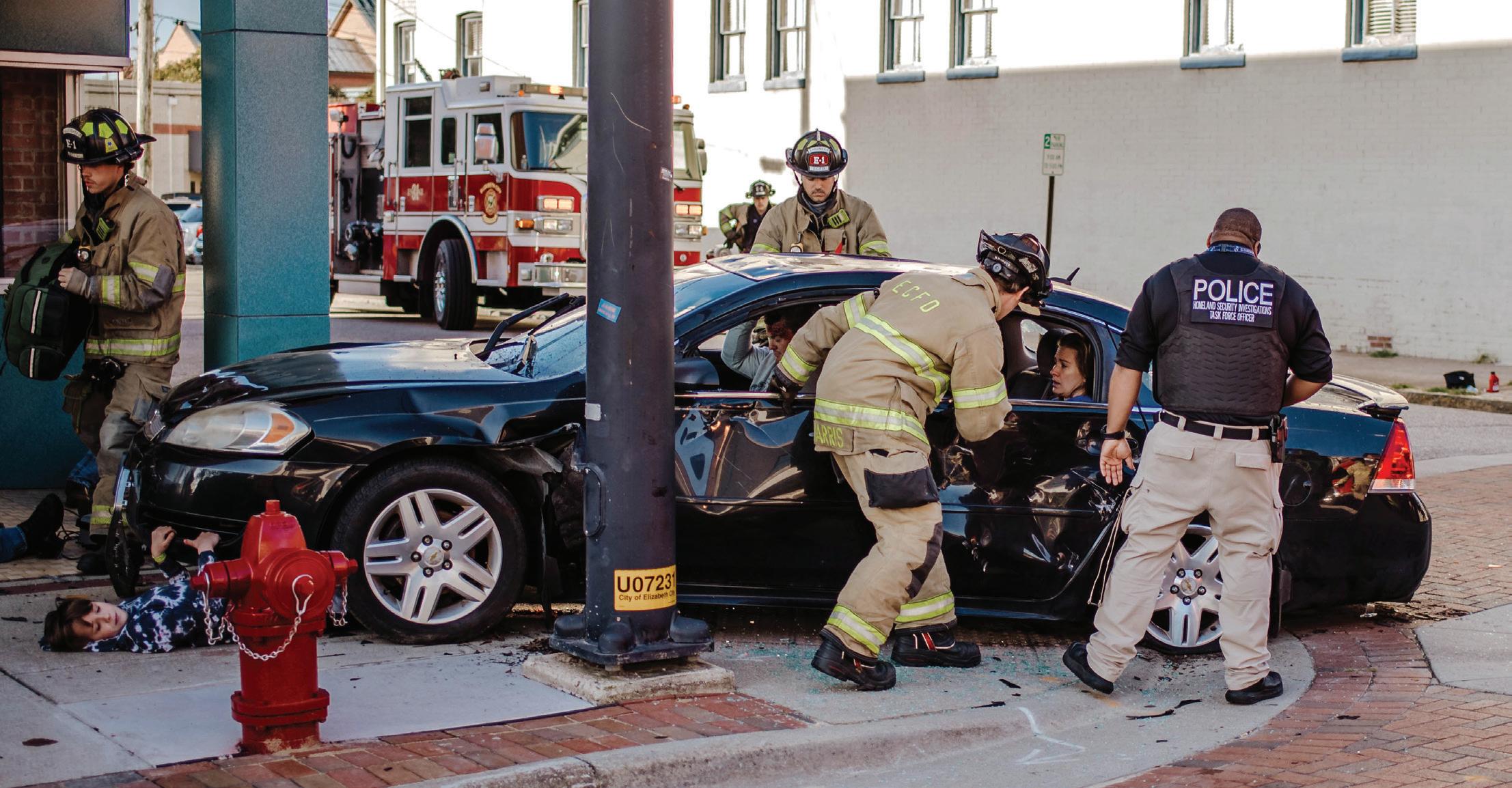
By NICHOLETTE CARLSON | The Municipal
Planning for the Elizabeth City, N.C., mass casualty exercise began in December 2023 and included collaboration and coordination between multiple different agencies.
Local, county and regional partners included Pasquotank-Camden Emergency Management; Elizabeth City Fire Department; Pasquotank County EMS; Elizabeth City Police Department; Pasquotank County Sheriff’s Office; Central Communications; Sentara Albemarle Medical Center; South Camden Volunteer Fire Department; Currituck County EMS; Gates County EMS; Perquimans County EMS; and Albemarle Transport Company. The exercise simulated
a high-impact incident during a large public gathering.
The mass casualty exercise took place on Oct. 19, 2024, after an initial planning meeting and a series of meetings from the planning team. Initial planning helped to establish the exercise’s objectives, define the parameters of the scenario and identify the primary stakeholders. The planning team comprised a variety of representatives from emergency management, fire, EMS, law enforcement, city officials, county officials,
ABOVE: The October 2024 mass casualty exercise in Elizabeth City, N.C., was a collaboration between Pasquotank-Camden Emergency Management and several other agencies. The planning team used the FEMA Exercise and Evaluation Program framework to guide the exercise. (Photo provided by Pasquotank-Camden Emergency Management)
communications and the hospital, which helped to guide the planning process using the Federal Emergency Management Agency Exercise and Evaluation Program framework.
“The team held a series of structured meetings, including the initial, midterm and final planning conferences, to coordinate logistics, develop the master scenario events list and
confirm each agency’s roles and responsibilities,” Joshua Wyse, Pasquotank-Camden Emergency Management assistant coordinator, explained. “Input was solicited from participating agencies to ensure realism and relevance to local threats and capabilities. The scenario was designed to simulate a high-impact incident during a large public gathering, requiring rapid triage, transport and coordinated response from on-scene personnel through to hospital care.”
The planning team developed evaluation guides, safety plans, protocols for communication and instructions for the exercise’s role players. There were also volunteer actors, local agencies and colleges within the community who played important roles.
“The end result was a dynamic, full-scale exercise that not only tested operational readiness but also strengthened interagency relationships and real-time decision making under pressure,” Wyse commented.
When it came to planning, the team faced three primary challenges. The first was the necessity to close main roads, affecting residents, businesses and parking, for several hours. Emergency management ensured all businesses and residents were notified well in advance, and many even took part in the exercise. The second challenge was that the exercise was held while response and recovery efforts were underway for Hurricane Helene. Many, including Wyse, had been in western North Carolina helping with efforts and returned right before the exercise. The third challenge was volunteers dropping out at the last minute or no show on the day of the exercise. Unfortunately, that meant certain injuries, a mutual aid department response to an incident at the Sentara Albemarle Medical Center and a few other specific items could not be tested as planners had wanted.
Volunteers for the exercise included public safety agencies and community members. Social media was one of the greatest tools for finding the volunteers.
“Well in advance, I put out a call via our social media channels,” Wyse described. “Community members were able to sign up for specific slots as either a role player or patient actor along with time slots depending on specific roles. Several off-duty public safety personnel also signed up to participate.
Mid-Atlantic Christian University’s men’s basketball team all played patient actors,
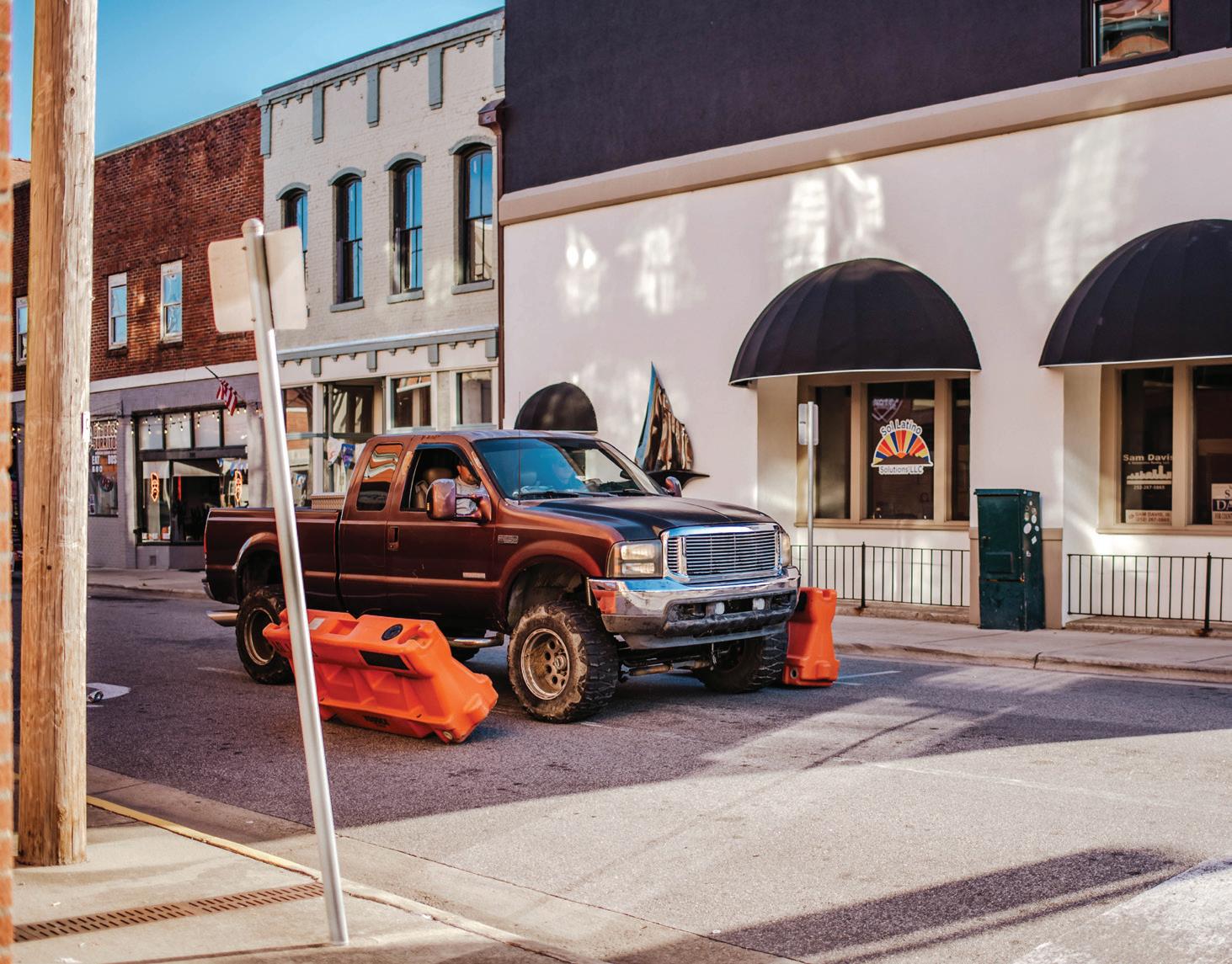
The exercise was as realistic as possible in depicting a vehicle attack during a crowded parade with a secondary incident involving multiple injuries and structural damage. (Photo provided by Pasquotank-Camden Emergency Management)

and Elizabeth City State University CERT team provided volunteers for moulage.”
Overall, there were over 60 community members, 10 public safety agencies, Sentara Albemarle Medical Center and Towne South Church who participated.
One of the most important parts of the exercise was ensuring all roads were properly blocked off.
“Securing the exercise area was a top priority to ensure both public safety and the integrity of the exercise,” Wyse emphasized. “We coordinated closely with local law enforcement, city officials and public works to temporarily block off streets and establish a secure perimeter around the exercise site. Road closures, detour signage and traffic control points were all strategically implemented to minimize disruption and maintain emergency access routes. All participants were given either lanyards or wristbands so that security personnel knew they were a part of the exercise. I personally walked door to door notifying residents and businesses about the exercise, the road closures and invited them to participate. Road closure signs were placed on all light poles the week prior. Additionally, multiple press releases and social media messages were sent out to include working closely with the downtown business liaison.”
The goal of the exercise was to be as realistic as possible to demonstrate real scenarios and test first responders.
“The exercise scenario simulated a catastrophic vehicle attack during a crowded parade followed by a secondary incident involving structural damage and multiple injuries,” Wyse described. “Responders were tasked with immediate life-saving actions, scene stabilization, triage and treatment, coordinated patient transport and unified command operations. Throughout the event, agencies practiced interoperable communication, resource deployment and decision making under pressure. EMS teams honed their triage skills using realistic patient actors, while law enforcement and fire personnel coordinated scene security, extraction and hazard mitigation. Dispatchers managed simulated 911 call and text volume while hospital staff tested surge protocols and emergency department coordination. The scenario was designed to be as lifelike as possible, allowing each agency to validate plans, train personnel and identify areas for improvement all in a controlled, collaborative environment.”

The exercise tested responders in stabilizing a scene, performing immediate life-saving efforts, coordinating patient transport, and triage and treatment for a variety of injuries. The communications center tested an influx of 911 calls coming in during such an event. The medical center staff tested their surge protocols and coordination with the emergency department. (Photo provided by Pasquotank-Camden Emergency Management)
The exercise’s goal was to train first responders to effectively manage complex incidents with multiple victims while also coordinating with various other agencies. It tested communication, collaboration and the ability to adapt under pressure, while also identifying a few areas for improvement.
“Full-scale exercises like this one allow agencies to test real-time decision making, communication protocols, resource deployment and interoperability in a high-pressure but controlled environment. They also reveal gaps in planning, highlight training needs and build confidence across agencies.”
Full-scale exercises are considered essential to ensure a department’s operational readiness. This mass casualty exercise was deemed a success, testing coordination between agencies from the initial response to final patient transport and strengthening the relationships between agencies.
Wyse said, “It reinforces relationships, identifies issues before a real crisis occurs and keeps response plans current and actionable. Each exercise is a learning opportunity, and the lessons from this one will directly inform how we plan the next making our community even more prepared for whatever may come.”

The goals of the mass casualty exercise were to test the communication, collaboration and ability to adapt under pressure of multiple departments working a complex incident with multiple victims. (Photo provided by Pasquotank-Camden Emergency Management)










By JULIE YOUNG | The Municipal
No matter if it is a wildfire, hurricane, tornado or a man-made disaster, emergencies happen, and the initial response can be overwhelming for those on the front lines. That’s why cities throughout the United States offer Community Emergency Response Team programs to help ordinary citizens step into the line of duty whenever and wherever they are needed.
Developed by the city of Los Angeles Fire Department in 1985 and adopted through a variety of local, state and national organizations, including the Federal Emergency Management Agency, the American Red Cross and Americorps, CERT trains volunteers in basic disaster response skills, such as fire safety, light search and rescue, team organization and disaster medical operations. The CERT program offers a consistent, nationwide approach to volunteer training
and organization that professional responders can rely on during emergencies, allowing them to focus on more complex tasks. In short, CERT is a proactive approach that boosts community self-sufficiency and decreases the reliance on external aid.
The Citizen Preparedness Corps is a program of the New York State Division of Homeland Security and Emergency Services that gives
ABOVE: A fire truck is used in a CERT exercise by a community emergency response team in Riverside, Calif. (Gerald Peplow/ Shutterstock.com)
residents the tools and resources they need to prepare for any type of disaster/emergency, respond accordingly and recover as quickly as possible to pre-event conditions. Led in conjunction with the New York National Guard and the American Red Cross, the CPC program began in 2014 and is held at various locations throughout the state.
Last September, Gov. Kathy Hochul announced that over 400,000 New Yorkers have participated in a CPC program over the past 10 years, which is not only a major milestone for the program itself but also makes these ordinary citizens some of the best prepared in the nation.
“The men and women of the New York National Guard are proud of the part that they have played in educating our neighbors and fellow New Yorkers in how to prepare for emergencies,” said Adjutant General of the New York National Guard Major General Ray Shields. “These trainings help people prepare to cope with emergencies that can occur at any time.”
customized approach
While the topics covered in community CERT programs are universal, such as assembling a disaster preparedness kit, creating an emergency plan, basic first aid and more, some states take it to the next level tailoring their offerings to the typical emergencies that are common for their area of the country.
Last September also National Emergency Preparedness Month the American Red Cross California Gold Country Region offered the Fired-Up Institute, a three-day event designed to help train volunteers to respond to the needs of the region in the event of a disaster. The program, which was held at Simpson University in Redding, Calif., offered response and recovery workshops, food safety/meal preparation workshops, shelter simulations, mass casualty response management and CPR/AED certification.
“With our propensity for wildfires, floods and other disasters, the California Gold Country Region of the Red Cross strives to ensure our volunteer workforce is properly trained to respond to the needs of the community any time of the year,” said Regional Disaster Program Officer Robin Friedman in an American Red Cross press release.
In April, Joliet, Ill., launched its CERT program just in time for tornado season. Volunteers learned essential skills, such as triaging victims, wound care, and weather spotting, which helps identification of severe weather patterns like funnel clouds.
In a FOX 32 article, John Lukancic, director of the Joliet Office of Emergency and Disaster Management, noted that the city’s CERT program was inspired by the 1990 F-5 tornado in Plainfield and trains participants to respond to just about anything that could affect the community. About 35 residents registered for the inaugural program, and when a situation arises, they will be the initial responders to disasters in their own neighborhoods.
“In a disaster situation, people are often overwhelmed, and sometimes the only

New York Gov. Kathy Hochul speaks at a press conference in Queens addressing the impact of Hurricane Ida’s remnants on Sept. 2, 2021, in New York City. New York’s Citizen Preparedness Corps gives residents the tools and resources they need to prepare for any type of disaster/emergency. (Ron Adar/Shutterstock.com)
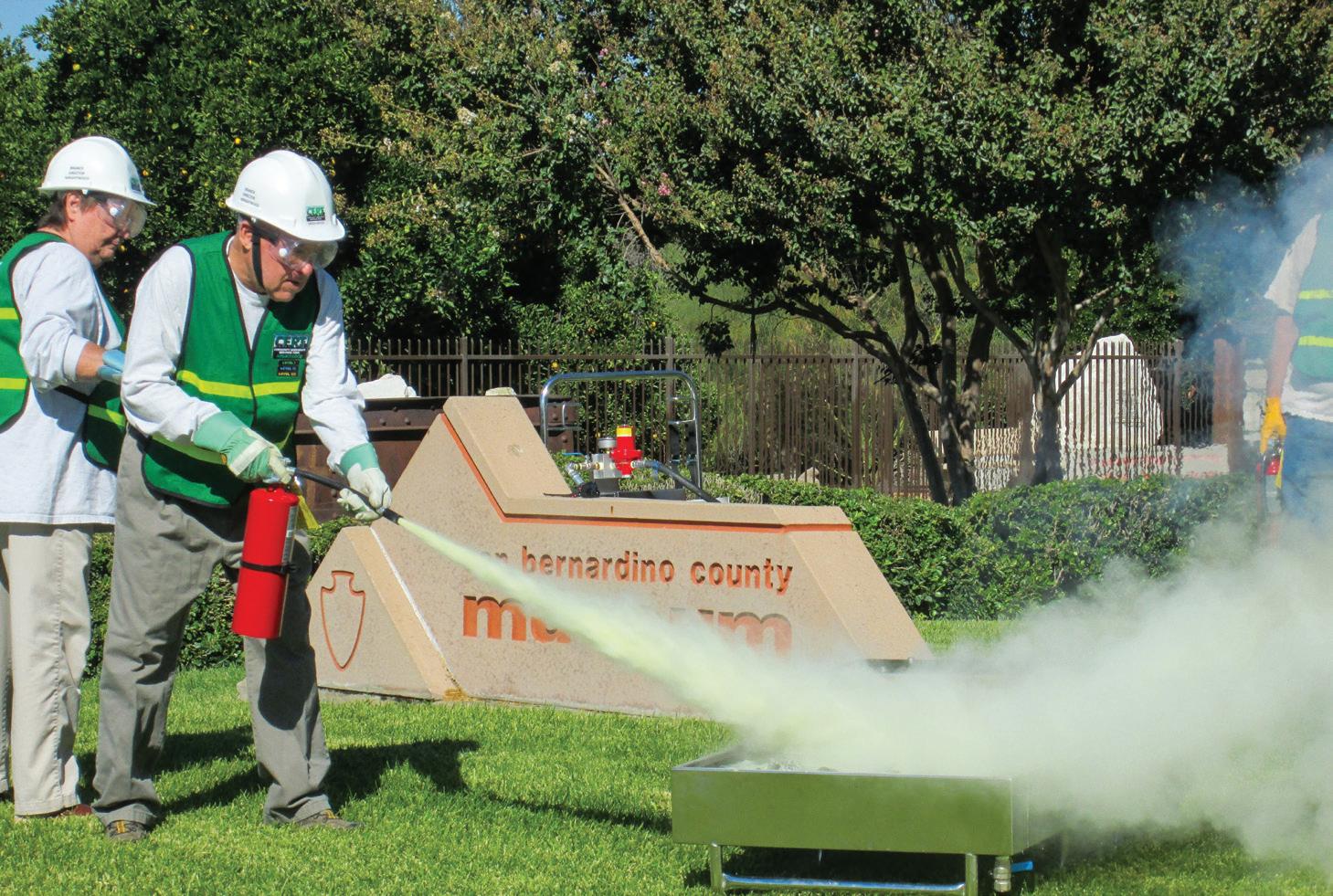
The local community emergency response team in Redlands, Calif., displays how to use a fire extinguisher. (Gerald Peplow/Shutterstock.com)
If you are interested in developing a CERT program in your community, visit https:// www.fema.gov/emergency-managers/individuals-communities/preparednessactivities-webinars/community-emergency-response-team to learn more, including how you can customize the program to fit your needs.
thing they may need is another human being to talk to … and that’s one of the things that we try to provide here too,” he told FOX 32.
Of course, for a CERT program to be successful, it must earn and maintain community buy-in as well as volunteers who will sustain it. According to Denise Wright, emergency manager for Waseca County, Minn., her department uses the county fair as a recruiting opportunity where people can learn more about the program and sign up for a class. She said that their members are also very good about spreading the word about CERT programs to their friends.
“We feel that the more the community sees us out and about, the more familiar they will be with us,” she said in a press release. Annually, CERT members volunteer to work events in the community, including steak fries at the Waseca American Legion, breakfasts at the Waseca VFW and first-aid sites at local parades. “This gives us an opportunity to engage with people in our community and answer questions about the group.” M
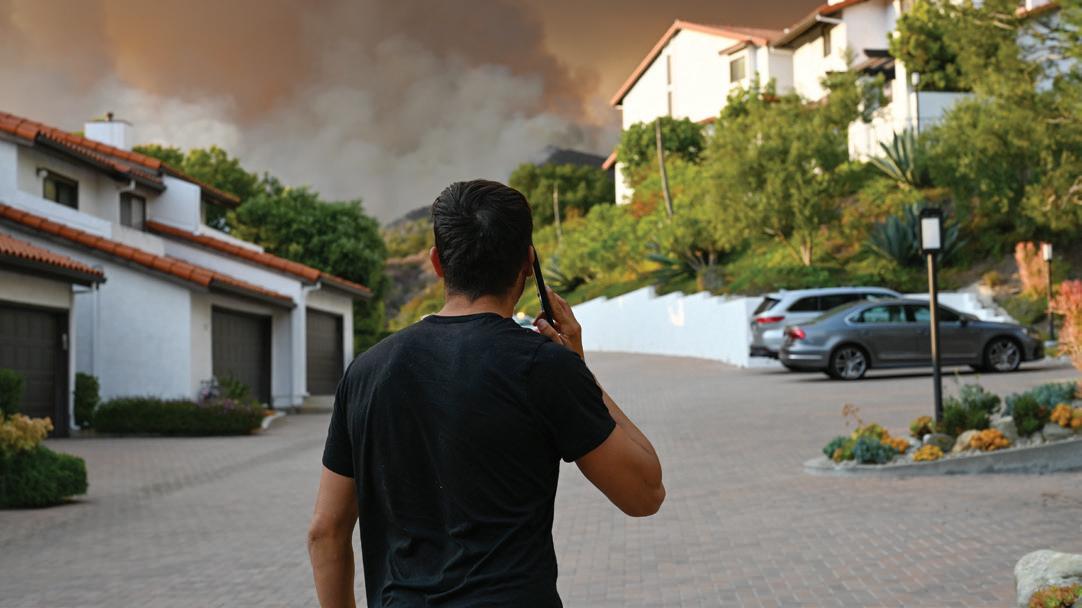
CERT programs equip communities with the skills to face a variety of emergencies, including wildfires. Communities can tailor their programs to match local circumstances. (BrittanyNY/Shutterstock. com)
Sources: https://www.fox32chicago.com/news/joliet-cert-program-preparing-residents-disasters https://dps.mn.gov/news/whats-cert-why-should-my-community-have-one https://www.governor.ny.gov/news/governor-hochul-announces-more-400000-people-have-completed-new-york-states-citizen https://www.redcross.org/local/california/gold-country/about-us/news-and-events/press-releases/american-red-crosslaunches--fired-up--training-institute-to-pre.html?srsltid=AfmBOopvRqZCmGPwGO4TFB_Z-1WSDpnUEcVtcJAVakK7p994gSAxYGP0


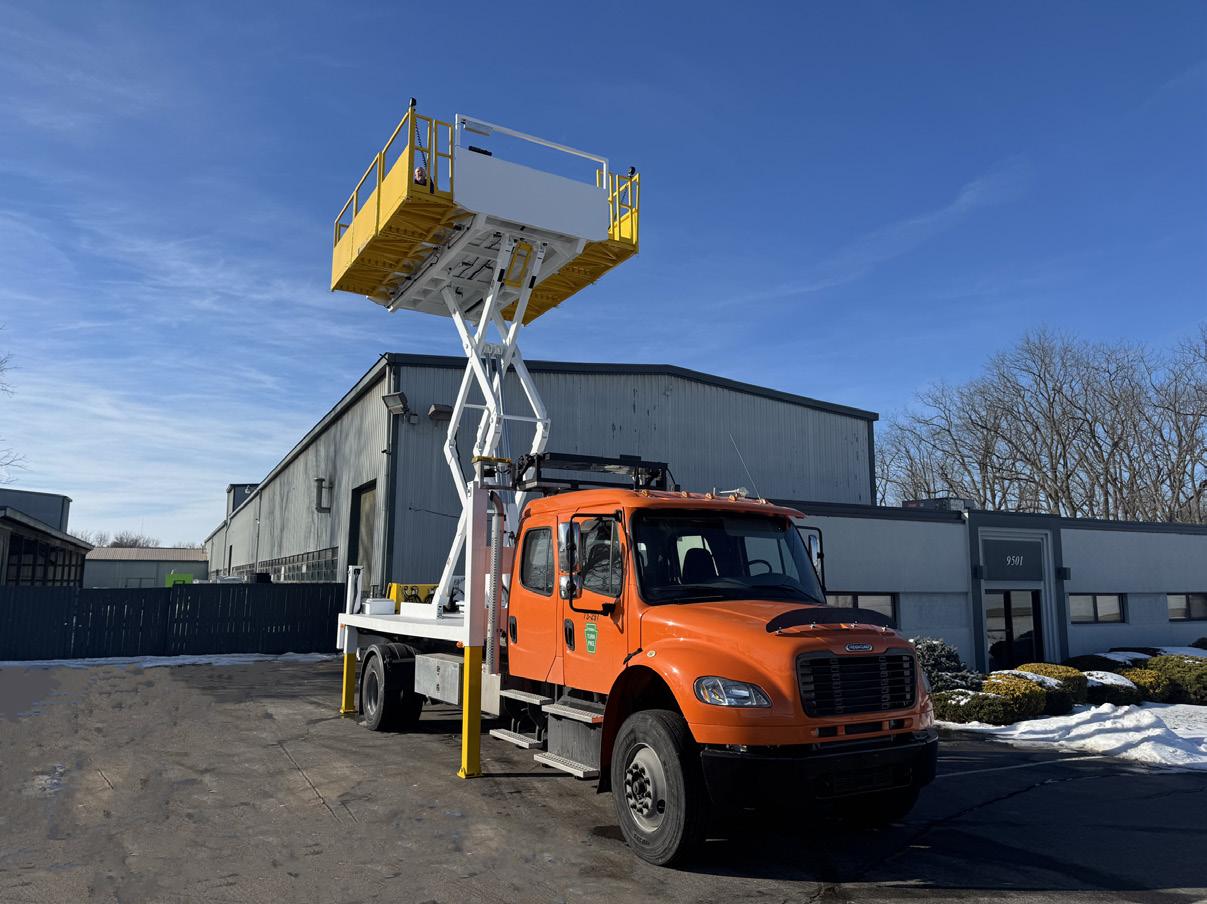










Flexible hoses for sweepers — built to withstand vibration, bends, and heavy use.
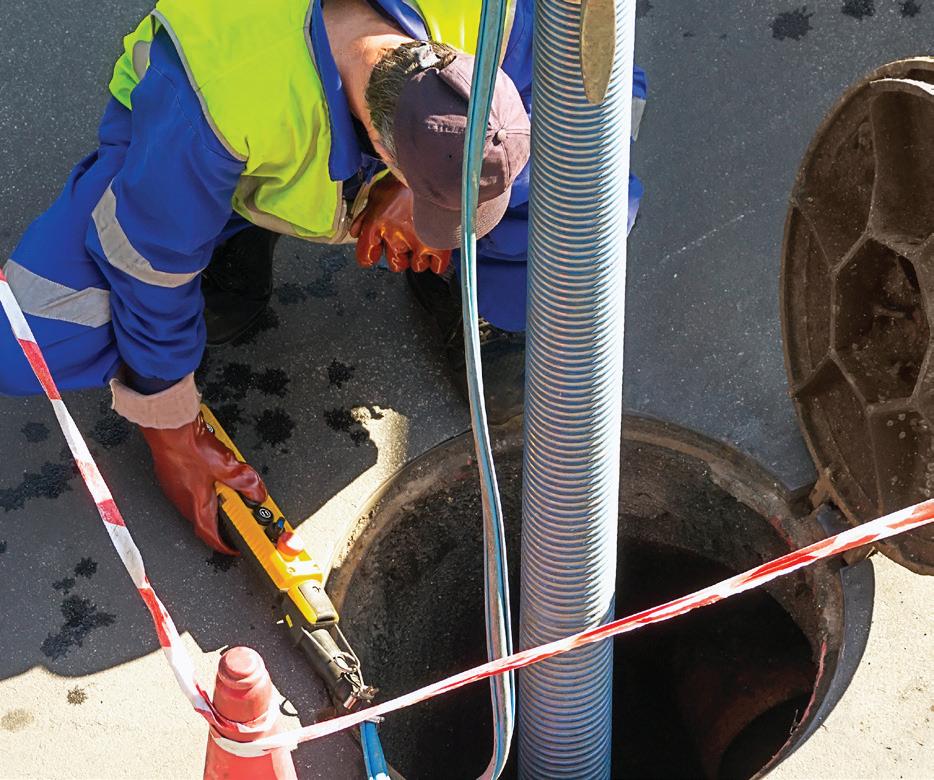
Abrasion-resistant hoses built to handle twigs, wet leaves, and road grit with ease. “The items purchased were exactly as described and delivered as promised. The next time we are looking for debris conveying hose we will be back.”
Durable hoses for sewer pumping and cleaning — fits pump trucks, combo units, and portables.
- Gil G.

By NICHOLETTE CARLSON | The Municipal
A solid waste voucher program was recently set up in Douglas County in Oregon during the March flood emergency in a partnership between the Douglas County Solid Waste Department and the Douglas County Emergency Management Department. This voucher program helped residents remove solid waste damaged in the flood quickly. The swift removal of flood-damaged waste greatly assists in recovery efforts for county residents to help get their homes and lives back in order while also preventing safety concerns.
The voucher program idea came from the county’s experience with a similar program following the Archie Creek fire in 2020.
“Douglas County has a financial assurance agreement with the Department of Environmental Quality that explicitly prohibits Douglas County from taking waste
ABOVE: During the flood emergency in March, Douglas County, Ore., used overlay maps to identify potential flood zones for vouchers. (Photo provided by Douglas County, Ore.)
and depositing it in our landfill for ‘free,’” Douglas County Commissioner Tom Kress explained. “The idea for the voucher program came directly from our experience during the Archie Creek fire in 2020. At that time, we needed a method to help landowners clear fire-damaged ash and debris to allow for rapid rebuilding. The Department of Environmental Quality permitted us to accept nonhazardous debris at our landfill at no cost for those victims, and it worked very
well. So much so, in fact, that other counties later implemented similar efforts. That past success is what inspired us to adopt a similar model in response to the recent flood.”
Given the past collaboration with the Department of Environmental Quality and the success of the program, when Douglas County experienced the flood emergency this year, it was assumed a similar program could easily be implemented. However, that was not the case.
“Because it was essential to remove waterlogged materials quickly from residents’ homes, we moved swiftly,” Kress described. “Simultaneously requesting permission from the DEQ to run the program while initiating it. We assumed the DEQ would again support the effort given the precedent in 2020. Unfortunately, that assumption was incorrect. This time the DEQ did not approve the program but was willing to overlook our limited program of individual-only vouchers.”
Since many residents had already contacted haulers, this created a challenge for the county. “To manage the process effectively, our Geographic Information System department built an overlay map identifying potential flood zones across Douglas County. Using that data, our solid waste department issued vouchers on a case-bycase basis.”
The department had to use the data to verify the resident was in an area affected by the flood. Once approved, residents could transport the flood-damaged waste to any of the county’s transfer stations or the landfill and present their voucher for free disposal.
Since it involved assisting in a flood emergency, much of the voucher program occurred simultaneously. “Due to the urgency, planning and execution happened in tandem,” Kress shared. “The reality of emergency response is that waiting for perfect conditions can delay much needed help. We believed, based on past experience, the DEQ would back our efforts retroactively. While they did eventually allow limited implementation, the restrictions associated with the financial assurance agreement created challenges. Still, our department moved quickly to establish eligibility, issue vouchers and coordinate across agencies to get the program up and running.”
Despite the challenges, the county’s quick response was well received by the residents who utilized the voucher program. It

Quickly removing flood-damaged items not only helps residents start necessary repairs to their homes, but it also promotes safety. Water-damaged items sitting in a home can create serious safety concerns, such as mold. (Photo provided by
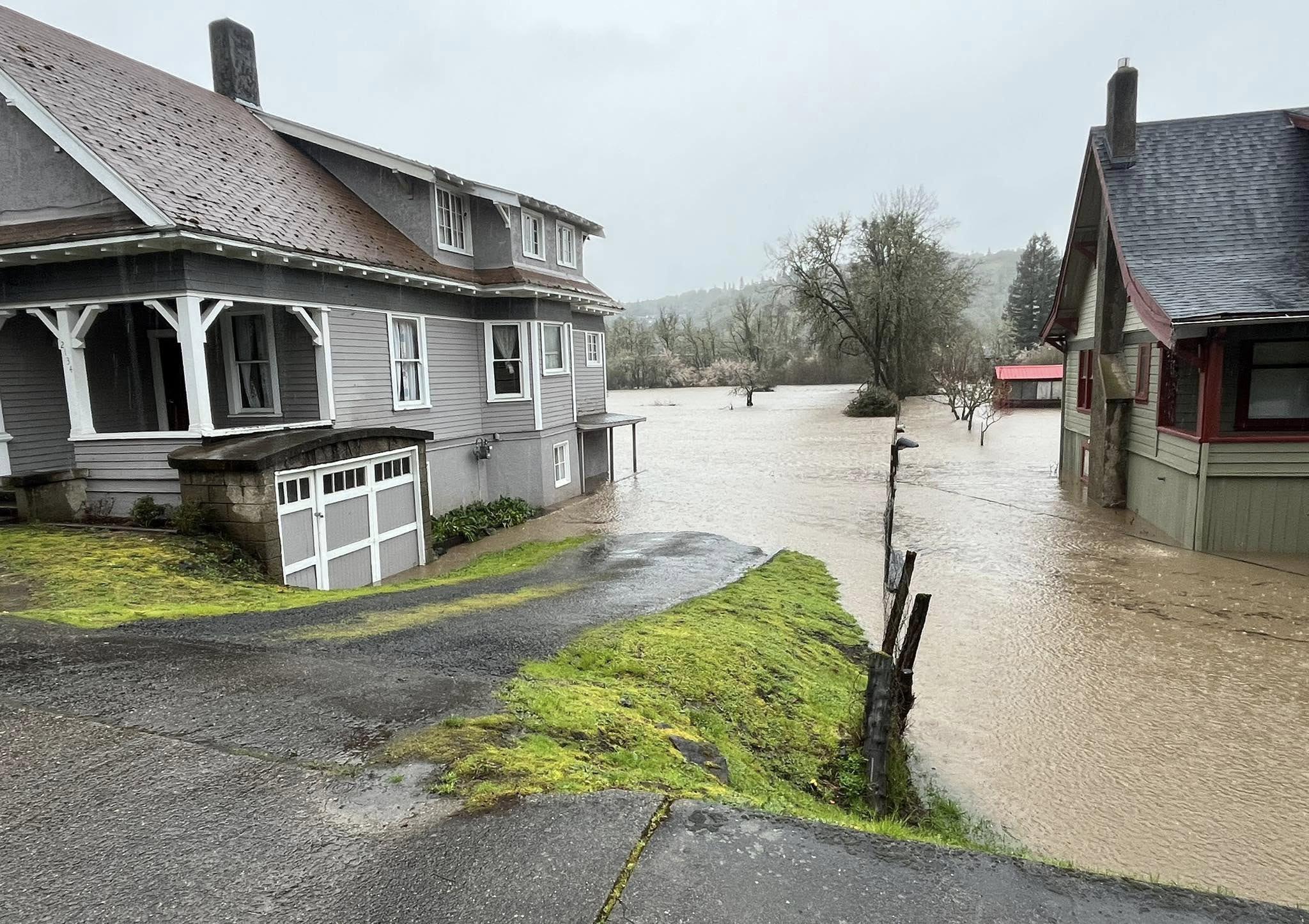
The greatest challenge seen by the county was the inability for residents to use commercial haulers to dispose of their waste because of the DEQ’s restrictions. Currently, the county is working on getting reimbursement for residents and the county’s accrued costs with a onetime grant from the state. (Photo provided by Douglas County, Ore.)
allowed residents to dispose of flood-damaged belongings quickly at no additional fee and assisted in their recovery efforts. However, the most common complaint was the residents’ inability to use commercial haulers. This caused frustration since many residents had already hired haulers. However, the voucher program is still considered a success for the county.
“It helped expedite cleanup and prevented health and safety issues from lingering flood debris,” Kress stated. “The primary challenge was navigating the DEQ’s restrictions, particularly the exclusion of haulers, which limited the reach of the program and caused some dissatisfaction.”
Because of the restrictions from the DEQ, the county accrued some costs. The state of Oregon agreed to provide the county with a onetime grant to help offset the voucher program’s revenue loss and provide reimbursement for residents who had already hired commercial haulers. While the county has not yet received the grant funds, it has moved forward with submitting detailed reimbursement spreadsheets.
“The program wound down organically as requests for vouchers tapered off,” Kress shared. “We never established a formal end date, but once demand diminished, it made sense to conclude the effort. While the community has largely moved forward, we’re still managing the administrative aftermath, especially the pending reimbursement from the state for the hauler-related expenses.”

The county came up with the idea for the flood voucher from a previous collaboration with the Department of Environmental Quality after the Archie Creek fire in 2020. During this tragedy, the DEQ allowed nonhazardous debris to be dropped at the landfill at no charge in order to allow residents to rebuild more quickly. (Photo provided by Douglas County, Ore.)





By NICHOLETTE CARLSON | The Municipal
The Warren, Mich., Police Department is taking another step toward breaking the cycle of domestic violence with the Operation Cycle Break initiative. This multifaceted approach puts an emphasis on protection for victims and swift justice for offenders as well as keeping offenders accountable and making resources readily accessible.
In the face of more than 9,100 domestic disturbance calls in the past two years, as well as major incidents, including homicides, with a domestic violence connection, officers realized there was a clear need for such a program in their community. After a new police commissioner came into office, the department began by working to discover what was driving violent crime in Warren: It turned out that at least 70% of aggravated assaults stemmed from domestic violence incidents.
Partnering with the Macomb County Prosecutor’s Office, city attorney’s office, 37th District Court, Turning Point Macomb and Wayne State University, the Warren Police Department developed a new,
less reactive response initiative for domestic violence. Operation Cycle Break provides victims with support and resources immediately, including education on victims’ rights and safety planning.
Dedicated weekly court days were set up to ensure domestic violence cases are dealt with rapidly and to ensure that offenders are quickly held accountable. High-risk offenders also receive unannounced follow-ups with proactive monitoring to limit their chances of re-offending. Additionally, services, intervention programs and support systems for both victims and offenders were expanded.
The initiative is a shift from reactive to proactive. The reactive approach left serious gaps in support and accountability. There was

When it comes to major incidents and violent crime in Warren, Mich., there was a domestic violence connection in over half the cases. This led the department to pioneer a new initiative — Operation Cycle Break. This is a new proactive approach to giving both victims and offenders of domestic violence the tools and resources to break the cycle. (Photo provided by the Warren, Mich., Police Department)
limited contact, with follow-ups done exclusively by phone and often no follow-up was done if a person could not be reached. This meant both victims and offenders typically did not receive the support necessary after a domestic violence incident. Justice was also typically slow, with victims receiving a court date letter in the mail up to 90 days after an incident.
Previously, essential lethality assessments were not being performed and unannounced visits were not conducted to check in on offenders and the welfare of victims. Counseling for offenders was not offered once bond was set. Such gaps often led to the cycle of violence repeating itself.
In the past, officers would typically ask the victim at a scene if he or she wanted to press charges against the assailant. Many were still reeling from the traumatic event and would not think through that question: They simply wanted to get out of the immediate situation.
Officers no longer ask that question at the scene of the incident. Instead, the facts are presented to a prosecutor to decide if charges should be filed. With this change, the department has already seen an increase from 20% to 90% of warrants being issued for offenders, which allows officers to issue a no-contact order, a no-alcohol order or put the person in jail if necessary.
With Operation Cycle Break, there is immediate follow-up with victims by phone and in-person. If primary phone contact cannot be established, the in-person follow-up is critical. Within 10 days of the initial incident, officers make certain that victims are safe and offenders are following the required no-contact order, if there is one. They are also required to complete the multi-question lethality assessment to identify a high-risk situation or high-risk offender and ensure those in high-risk situations receive the necessary support. The questions include previous threats of violence, violence to pets or children or whether the offender commits other crimes, such as drug offenses. If an offender’s score is 10 or higher, officers take a hard look at that

While this program only began in May, the police department is already seeing a large increase in the number of warrants being issued against offenders as well as an increase in victims showing up for court dates. In order to ensure quick justice, there is also a set day each week for domestic violence cases. (Photo provided by the Warren, Mich., Police Department)
person. It also ensures the judge receives all the pertinent information moving forward.
After being arrested, offenders receive a letter stating they will be actively monitored after they are released from custody. The monitoring includes unannounced visits, and they are given a pamphlet with local places where they may seek assistance. In some cases, the offender must receive mandatory court-ordered intervention counseling as a condition of bond. The hope is that, even if the case ends up getting dismissed, the offender will have still gone through months of court-ordered counseling and, as a result, will not re-offend.
“The goal is to lower domestic violence, not arrest more people,” Sergeant James Twardesky stated.
Previously, one of the biggest challenges was victims not showing up for court appearances. With Operation Cycle Break, when officers go to check on a victim between three and 10 days after the incident which allows the victim’s system to return to normal following a traumatic incident they are seeing how the victim would like to move forward and letting them know their options, including jail, probation and counseling for the offender.
“I think it’s a game-changer for them to have a say in what happens in court instead of just throwing people in jail,” Twardesky said. “It offers the victim some control of the situation.”
The program has resulted in an increase in victims showing up for court and an increase in the number of guilty pleas and court-ordered counseling. Those with a low risk of re-offending can even work to get the charge eventually removed from their record.
Court dates for domestic disturbances are every Wednesday and law enforcement, victim advocates and the courts collaborate in the legal process, which expedites it. If offenders do not appear for court, the officers take action to locate them.
Wayne State University is working to collect and review data to keep improving the new approach to domestic violence situations. Within the first 30 days of the program, there was a 33% increase in authorization of warrants for domestic incidents, compared to last year. The mandatory counseling for offenders component has been implemented, and there is quick apprehension of offenders who do not appear for scheduled court appearances as well as increased engagement with victims. The university also set up a spreadsheet to help calculate an offender’s lethality score.
The program began May 1, so it is too early for extensive data be available that would document Operation Cycle Break’s effect. However, the department is helping Wayne State collect that data as it comes in so the success of the program can be determined in the hope that it will continue. M

Lethality assessments are now being done on domestic violence offenders, including asking victims if there had been previous threats of violence or violence to children or animals. This assessment can help officers and the judge determine the appropriate order moving forward and determine the likeliness for an offender to re-offend. (Photo provided by the Warren, Mich., Police Department)


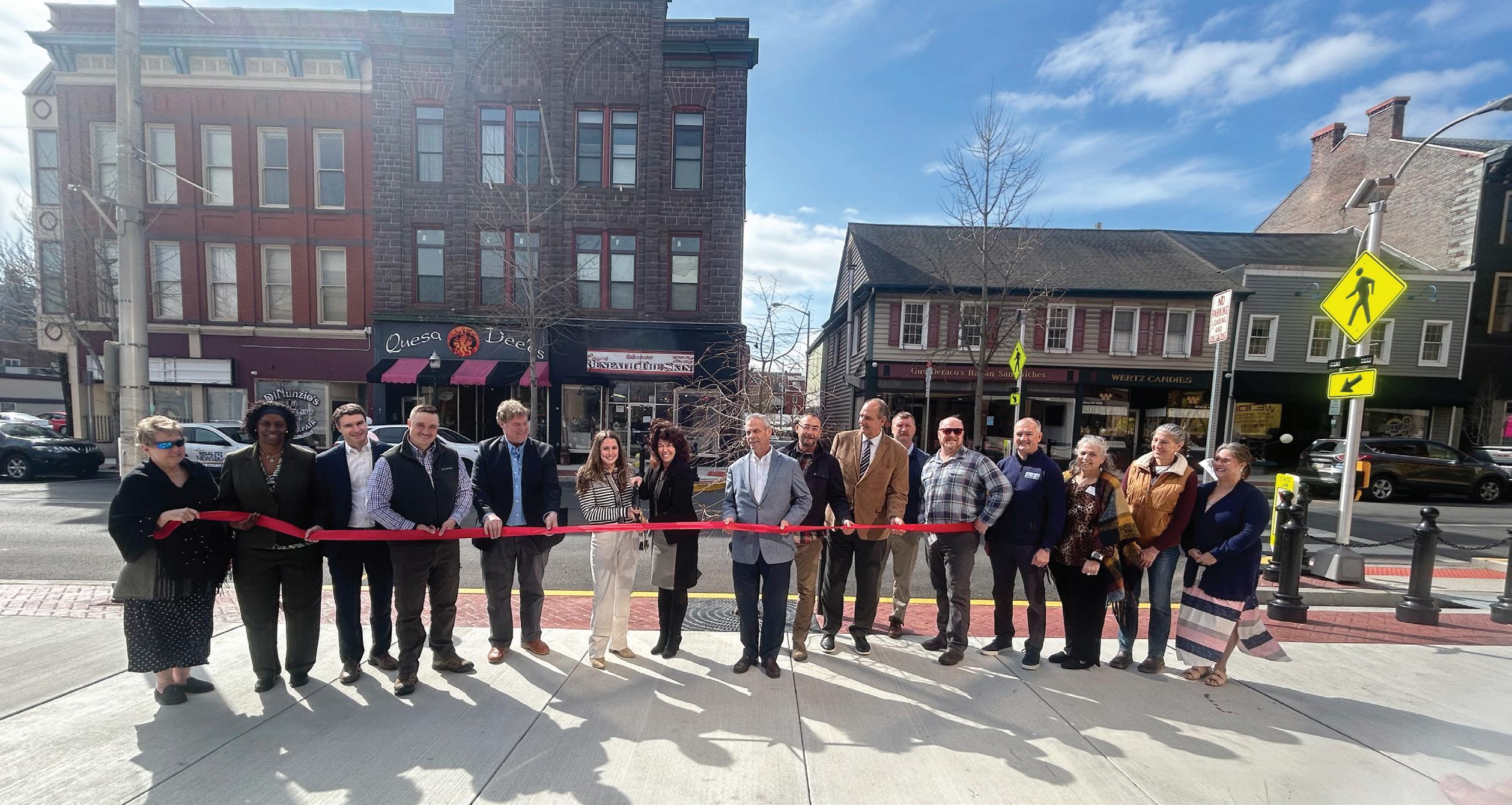
By JANET G. PATTERSON | The Municipal

As part of a 2016 Economic Development plan, Lebanon officials took on a multi-year project that focused on the lagging downtown area of this city in eastern Pennsylvania.
Lebanon Mayor Sherry Capello explained that “the idea for the Streetscape Project began in 2019, as city officials recognized the need to revitalize the core of Lebanon’s business district along Cumberland Street, which is U.S. Route 422.”
Lebanon’s roots date back to the 1720s, when the area about 20 miles east of Harrisburg, the state capital, was settled by German immigrants. The city’s original name was Steitztown, after founder George Steitz. Its early claim to fame was Lebanon bologna, a smoked, fermented and cured beef sausage that was created by the
Pennsylvania Dutch in the early 1800s and is still available today. Later, the city became home to the second largest steel producer, Bethlehem Steel.
The plan for downtown focused not only on the rich history of the city but on the convenience of both its residents and visitors. The first step was taken in 2022, when Lebanon City Hall moved from its longtime location on the edge of the city to Cumberland Street in the heart of downtown. The move was the result of a $2 million Redevelopment Assistance Capital Program grant from the Commonwealth of Pennsylvania.
The downtown revitalization plan added beauty to convenience by moving the best of Lebanon’s history into a new era. The focus area, from 4th Street to 12th Street, is a key two-lane route that is the backbone of downtown commerce and community activity. In addition to safety concerns about the roadway, Capello said the sidewalks, curbing, lighting and street trees along that stretch had deteriorated over the decades. City officials decided it was time to improve the pedestrian experience and safety and enhance the downtown’s appeal as an attractive place to live, work, shop and visit.
Over the 16-block area that covered both sides of the street, all the sidewalks and curbs were replaced, and beauty strips were constructed using decorative stamped concrete dyed red with an antique finish to resemble the traditional historic brick structures nearby.
“The iconic Victorian-style light posts were refurbished, with additional new posts installed to expand coverage. All dead or diseased street trees were replaced, and electric receptacles were added to each tree well,” Capello said. “This was added as a thoughtful feature that allows for tree lighting and easy access to power for downtown events.”
Part of the goal was to create a calming atmosphere for pedestrians as well as a safe one for motorists. That included four curb bump outs and two crosswalks with flashing beacons, making crossing Cumberland Street safer and more inviting.
There were a few hitches along the way that hearkened to the city’s nearly 250-year history. For example, properties along Cumberland Street had coal chutes and basements that extended under the sidewalks. These areas required 21st century solutions in order to stabilize them. In addition, a couple of blocks needed stormwater drainage improvements to solve persistent flooding issues.
Capello said an additional challenge was the tight deadline established by the Pennsylvania Department of Transportation, which was set to complete the fourth and last phase of a multiyear paving project on Cumberland Street.
“All curbing had to be completed in time for the paving to proceed. Thanks to close coordination and diligent work by the construction crew, all curbing was finished on schedule.”
Capello added that applying for funding to accomplish the Streetscape Project began in 2019 and continued until it was secured in 2022.
In addition to the earlier grant for the relocation of city hall, the Streetscape Project was funded with a combination of grants and local resources that included a $100,000 Pennsylvania Department of Community and Economic Development Multimodal Transportation Grant. The rest of the funding was from the city’s allocation of American Rescue Plan Act funds.

The more-than-$5-million construction contract was awarded to Doug Lamb Construction of Elizabethtown, Pa. Steckbeck Engineering and Surveying of Lebanon led the engineering and design work.
Community partnerships helped put finishing touches on the revitalization. The Community of Lebanon Association, for example, purchased and installed hanging flower baskets and planters for colorful seasonal plantings. The city also dedicated a summer maintenance employee to focus completely on beautification efforts such as watering flowers, sweeping sidewalks, removing litter, pulling weeds and painting existing fixtures to blend in with the streetscape’s Victorian aesthetic, the mayor added.
In addition to safety and beauty, the revitalization provided a better infrastructure for supporting events and activities in the heart of downtown Lebanon.
Capello’s advice to other municipalities considering a downtown revitalization project is to be persistent in seeking funding, as well as engaging the community early and often and planning ahead to ensure coordination with other infrastructure projects.
“While construction in any downtown area is disruptive, the city worked hard to communicate and coordinate with property
owners and businesses throughout the process,” she said. Many Lebanon business owners not only expressed support and gratitude for the improvements but have also recognized their long-term value.
“Residents and visitor alike have praised the beautiful, welcoming streetscape as an important investment in Lebanon’s future and a visible commitment to revitalizing the downtown.”
Future plans for improvements include a pedestrian minipark that will transform a little-used walkway into a public green space with greenery, lighting, archways and seating. That project should be completed late this summer. Planning has also started for the city’s first parking garage, which will serve the long-term parking needs of downtown residents, employees and visitors. Finally, Lebanon is launching a Downtown Strategic Plan in partnership with Retail Strategies, a consulting firm, to identify action items, recruit businesses, support existing businesses and guide further development of the downtown area.
Capello, who has been mayor since 2010, expressed her delight in the downtown project, saying, “the Lebanon City Streetscape Project exemplifies what’s possible when a municipality commits to improving its public spaces, even in the face of challenges.”
She noted that the project “showcases how historic character, thoughtful planning and modern functionality can come together to create a vibrant and welcoming downtown core, building momentum for future investments and ensuring downtown Lebanon remains a destination for generations to come.”




By DANIELLE LUND | The Municipal
A quiet, but determined, revolution is taking place in Statesboro, Ga., led not by long-time civic leaders or elected officials, but by the city’s youth. Formed in February 2023, the Statesboro Youth Council has emerged as a powerful force for community improvement, civic engagement and youth advocacy.
The council’s origins are rooted in an urgent need identified within the city. Prior to its creation, there was no formal platform for youth voices in local government or community planning. Through the Village Builders Initiative, an opportunity arose to create a program coordinator position to fill this gap: With it, the foundation for the Youth Council was laid.
“There was no youth voice at the table. That silence made it clear we needed to do something different,” said Dr. LaSara Mitchell, who serves as the youth council program coordinator. “We created the group to make sure young people weren’t just present, but so that they could see themselves as leaders in the community.”
The council’s mission was clear from the start: to give young people the tools and opportunity to make meaningful, lasting change in the
ABOVE: Members of the Statesboro Youth Council pose in front Statesboro City Hall. The council aims to give youth in the community a voice. (Photo provided by Statesboro, Ga.)
community. Now in its second year, it consists of more than 45 active youth members guided by a five-member steering committee. Their projects span beautification, civic engagement, mental health, public health, literacy and inclusion initiatives.
One of their earliest and most visible accomplishments has been the revitalization of the Willie McTell Trail, a previously neglected area in the city that had become synonymous with disrepair, litter and safety concerns.
“The trail really needed some love,” Mitchell said. “There were benches falling apart, no water fountains, and it just wasn’t a space families wanted to use.”
The Youth Council envisioned something better. They applied for a placemaking grant and secured $500, an amount later matched by the City of Statesboro. Community partners soon joined in, and with additional donations from organizations such as the Georgia Municipal Association, local Rotary Club, the public works and Statesboro Police departments and the library, they were able to raise over $8,000 to fully transform the trail.
The youth didn’t just plan the project, they participated every step of the way. They selected the new seating styles, helped design landscaping improvements, and worked side by side with public works employees to install benches, tables and water fountains. They removed brush, laid sod and created a more inviting space for families, walkers and bikers alike.
“We didn’t just sit in meetings. We were out there working, designing, planting,” said Mitchell. “These young people saw a space that had been forgotten and made it into something beautiful.”
The process was not without challenges, however. Severe weather, including flooding from Hurricane Debby and a winter snowstorm, caused the council to miss key deadlines and delay construction.
“We experienced what it looks like to stay dedicated to a vision, even when things go wrong,” Mitchell said. “That was the real lesson: how to persist and how to lead through obstacles.”
Even as storms stalled progress, the council pressed on. Members organized fundraising events and concerts to raise money before requesting outside support, which demonstrated not only initiative but responsibility and ownership.
“We wanted the community to see we were invested,” Mitchell said. “They weren’t going to support a project unless we showed we were committed first.”
Today, the trail is no longer just a path, it’s a symbol of what youth leadership can accomplish. With benches, fountains and new landscaping in place, the space is now a hub for families, youth and community gatherings. And maintenance is ongoing: The youth council conducts trail clean-ups every other month to ensure the space stays safe and beautiful.
While some residents had concerns about potential vandalism or loitering, the revitalized space has defied expectations. The homeless population that once occupied the area has since moved on, and the trail has taken on a new identity as a welcoming, cared-for public space.
“We knew there might be concerns,” Mitchell said. “But the opposite happened. When you create something beautiful and put youth in charge of it, people respect it.”
With this success behind them, youth council members are already looking ahead to Phase Two of their vision. Current plans include working with the Statesboro Library to create a reading park, aimed at encouraging early literacy and providing children with an outdoor educational experience. Additional improvements such as signage and more advanced landscaping are also in discussion.
The trail project is just one piece of a much larger picture. The council continues to meet monthly, developing initiatives focused on mental health, education, community advocacy and inclusion. A pressing issue it has taken on recently is the closure of the city’s Boys and Girls Club. Youth members are actively searching for solutions to fill the after-school programming gap for children who need additional support.
Their advocacy also extends into local government and education policy, with members making presentations and proposals to city officials, school boards and civic groups.

In 2024, the Youth Council had the distinction of representing Statesboro at the All-American Cities competition in Denver, as the only delegation from Georgia to attend. (Photo provided by Statesboro, Ga.)

Statesboro Youth Council members pose by a giant chess set. Chess Park had an official ribbon-cutting ceremony on Tuesday, April 15, 2025, on the Willie McTell Trail in downtown Statesboro. (Photo provided by Statesboro, Ga.)
“They are advocates for so many things, like mental health, education and inclusion,” Mitchell shared. “They’re not just participating. They’re pushing change forward.”
In 2024, the youth council had the distinction of representing Statesboro at the All-American Cities competition in Denver, Colo. It was the only delegation from Georgia to attend.
“We didn’t win, but we competed alongside some amazing cities,” Mitchell said. “And we’re planning to reapply and attend again next year. It was an incredible learning experience.”
Through it all, collaboration has remained at the core of the model. Every milestone has been the result of partnerships with the city, with nonprofits, and most of all, among the youth themselves.
“They’re not waiting to be tomorrow’s leaders,” Mitchell said. “They’re leading now.”
The Statesboro Youth Council has redefined what youth engagement looks like in a small city. With strong leadership, community backing and a growing list of accomplishments, their work has just begun. Its impact is already undeniable.

By JULIE YOUNG | The Municipal
As part of a decades-long commitment to reduce greenhouse gas emissions, the city of Aspen, Colo., is transitioning its fleet to electric and zero-emission vehicles.
In 2021, Aspen adopted ambitious, science-based targets that called for a 63% reduction in emissions by 2030 and a 100% reduction by 2050, compared to 2017 levels. The Fleet Zero Emissions Roadmap was approved by the city council in 2022 and is Aspen’s most up-todate planning document: It outlines a path to achieve those goals through the introduction of zero-emission vehicles and equipment into the fleet by 2050.
According to Tim Karfs, sustainability programs administrator, previous electric vehicle planning documents include the 2017 Aspen EV Readiness and 2022 Public EV Charging Infrastructure Masterplan, which both signaled a need for greater numbers of EVs in the city fleet. However, those plans did not provide clear directions for staff to prioritize which vehicles should be replaced or how they would be charged. Before the Fleet Zero Emissions Roadmap, greenhouse gas
ABOVE: One of Aspen’s fleet vehicles fuels up at a charging station. As a GoEV City, Aspen, Colo., is committed to having a 100% emission-free fleet by 2050. (Photo provided by Aspen, Colo.)
reduction was not a standard for decision making in those internal processes.
“Moving city vehicles away from fossil fuels and towards electric and zero-emission alternatives is considered relatively low-hanging fruit and helps demonstrate Aspen’s climate values and set a strong precedent for electrification to the rest of the community,” he said.
On July 12, 2022, Aspen was named the state’s 11th GoEV City, part of a coalition of Colorado cities and counties committed to achieving the transition to 100% electric and zero-emission vehicles by 2050. The group shares best practices for electrification through networks established within GoEV City, and a pledge to transition their vehicles helps support efforts to communicate the sense of urgency
behind reducing local tailpipe emissions to help offset the worst impacts of a global climate crisis.
With 17 electric vehicles and four plug-in electric hybrids in the city fleet as of July, the Aspen Police Department has paved the way as an early adopter of EVs. A third of its total fleet of administrative and patrol cars are now electric.
Karfs said that Aspen is a unique case study for fleet electrification because electric and zero-emission vehicle technology is tested to its limits in terms of elevation and inclement weather. The Fleet Zero Emissions Roadmap started a process of strategic restructuring to accommodate additional EVs, and as part of that effort introduced a standardized procurement form, called an EV decisionmaking matrix, in which every vehicle that is up for replacement is assessed for EV replacement, an analysis of chargers and buildings and identification of training needs.
“We’re not trying to replace a certain number of vehicles per year or a percentage of the fleet by a certain year. Instead, we’ve identified what the city can do in the next several years to plan for and implement increased electric and zero-emission vehicles usage,” Karfs said. “We just finished a five-month telematics pilot that involved vehicles and equipment across the city’s fleet to better understand how to introduce EVs, and that is going to help inform some EV charging infrastructure decisions looking ahead.”
Karfs said fleet fuel use decreased by about 3% in 2023 compared to 2019, which the city sees as a win. The transportation sector, and specifically the use of gasoline and diesel fuel, represents one of the largest sources of emissions in Aspen, both at the community and municipal level. Fleet vehicles and equipment are the second largest assets the city owns behind its buildings.
“These emissions are directly within the city’s span of control and represent one of the most direct opportunities for greenhouse gas reductions among city-owned assets,” he said.
Electric vehicles are one of the more noticeable indicators of a city’s efforts to reduce its emissions footprint. The Aspen Police Department has also created custom wraps on some of the electric vehicles in the fleet to draw further attention to the initiative. For

The city of Aspen is the 11th Colorado community to be named a GoEV city and become part of a coalition of Colorado-based cities and counties committed to achieving the transition to 100% electric and zero-emission vehicles by 2050. (Photo provided by Aspen, Colo.)

communities looking to make the switch to an electric or zero-emission fleet, Karfs said it’s important to celebrate successes – not only to note incremental progress, but also as a way to share facts on total cost of operations and greenhouse gas reduction savings.
“It’s been a huge advantage of ours to have a city council that invested in the transition and
To help promote its electric and zero-emission fleet, the Aspen Police Department has customized wraps to advertise the city’s commitment to emission footprint reduction. (Photo provided by Aspen, Colo.)
has supported staff by approving strategic documents such as the Fleet Zero Emissions Roadmap,” he said. “The journey to a 100% electric and zero-emission municipal fleet needs buy-in from all levels, and making sure the benefits are understood by staff and city leadership alike is an important step.”
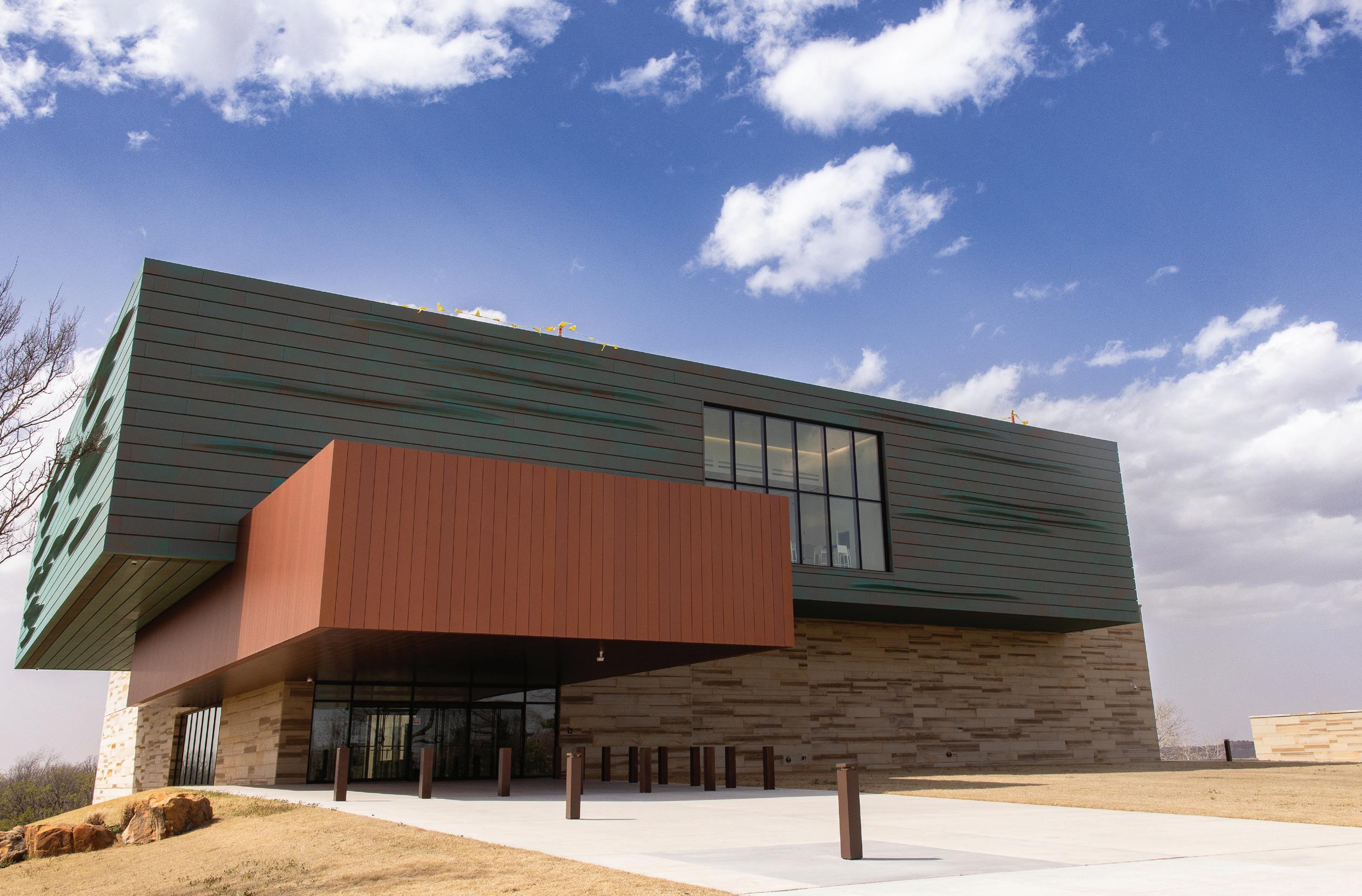
By BETH ANNE BRINK-COX | The Municipal
When a person thinks of Oklahoma, it might be of the famous musical by the same name, or Native Americans, tornadoes or any number of other things, including its nickname “The Sooner State” and the college football team known as the Sooners. But not many people are likely to think of an art collection.
William Thomas Gilcrease did, though. He was an oilman and the founder of the Thomas Gilcrease Institute of American History and Art, now known as the Gilcrease Museum.
He was affectionately called “Indian Tom,” and he was of Creek descent. Gilcrease collected art and established a private museum for its display: He donated it to the city of Tulsa in 1955, with an agreement that the city would build a proper place to preserve and display it.
That’s just what Tulsa has been doing, and it is beginning anew with a ribboncutting ceremony in November 2024. The old museum was demolished, and new
construction began on the same spot in the Osage Hills. Gilcrease’s grandson, Thomas Gilcrease Denney, said the location was where his grandfather wanted it, “for the citizens of Tulsa and Oklahoma.”
The new building will cost $137 million. Tulsa voters approved the majority of that funding, while private donors raised $49 million showing their approval of the project and the way they value the collection. It will be displayed again when everything has been completed on a date projected to be in 2026. The building will be of sizable proportions: The collection consists of more than 200,000 objects.
ABOVE: Tulsa, Okla., voters approved the majority of the funding for the new Gilcrease Museum. Construction began in 2024. (Photo provided by Tulsa, Okla.)
Mona Chamberlin, executive director for marketing and communications at the University of Tulsa, explained that the museum is owned by the city of Tulsa and managed by the university.
“The original Gilcrease Museum, founded by Muscogee or Creek Nation citizen Thomas Gilcrease, opened to the public in 1949. Over the decades, the museum expanded in a patchwork of additions and renovations that ultimately resulted in an aging, inefficient complex,” Chamberlin said. “The need for a new structure was driven by the inability to meet modern museum standards for collections care, exhibitions and visitor experience. The new 95,000-squarefoot building is a much-improved space that meets contemporary standards for care of Gilcrease’s extensive collection and touring exhibitions.”
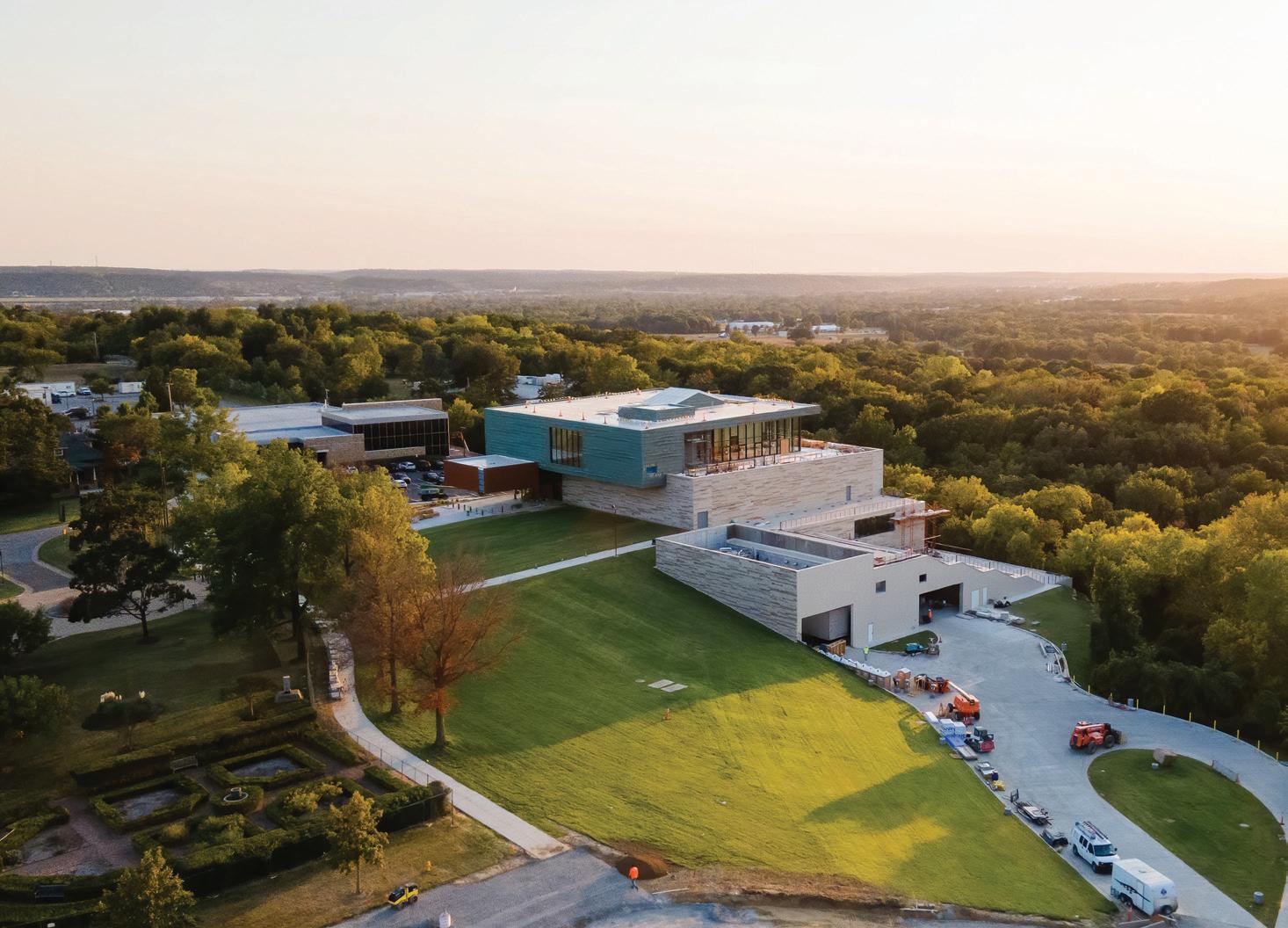

The project began when the facility closed on July 4, 2021. Demolition followed in January 2022, with construction beginning in 2024.
The new Gilcrease Museum was designed by SmithGroup, one of the world’s preeminent integrated design firms. Located within the Osage Nation reservation boundaries, the new building is conceived to align cardinal directions with natural elements and experiences: north, sky; south, earth; west, night; and east, day. The color and material palettes for the building reflect the art deco styles found throughout Tulsa, including the use of stone and gilded metals.”
“The lower level of the building includes earth tones, creating a connection to the ground, while the upper level utilizes sky tones, blurring the line between architecture and the sky,” Chamberlin continued. “A three-story atrium will orient visitors, while other spaces throughout the building frame views of downtown and north Tulsa. Panoramic views of the Osage Hills will create experiential moments between visitors and the great American landscape that surrounds the museum and grounds.”
Like many projects of this scale, the timeline was impacted by COVID-19-related factors including inflation, supply chain disruptions and increased labor costs. Tulsa voters helped close part of a $20 million
budget gap through the 2023 Improve Our Tulsa 3 initiative. “As of now, the museum is on track for construction completion and occupancy by fall, with the public reopening set for early 2027.”
The work continues steadily. “The move is scheduled to begin in November after the building is completed and has undergone the critical stabilization period needed for museum-grade environmental conditions,” Chamberlin said. “This includes time for materials to off-gas and temperature and humidity to be carefully monitored and adjusted to ensure a safe environment for the collection. The move itself is a highly specialized process managed by our collections team and trained art handlers, ensuring that each object is transferred with the highest level of care and documentation.” It’s hardly the kind of thing where a person grabs his or her neighbors and friends, packs boxes and moves it all in a day. Exhibition installation will begin in 2026.
“Even though the building has been closed, Gilcrease remains deeply connected to the community. In 2022, museum staff launched Gilcrease in Your Neighborhood, placing high-quality reproductions of works from the collection in public spaces across Tulsa parks, community centers, libraries, grocery stores and other unexpected places making art accessible beyond
the museum walls, Chamberlin added. “We also presented ‘Past Forward: Native American Art from Gilcrease Museum,’ a traveling exhibition that toured major institutions nationwide in 2024–25. To ensure our collection stayed accessible in museum settings, we placed long-term loans with partner institutions, including the National Cowboy and Western Heritage Museum in Oklahoma City and Crystal Bridges Museum of American Art in Bentonville, Ark.”
While the museum is hibernating, so to speak, education and outreach efforts have not stopped. “We expanded partnerships with Tulsa’s Any Given Child program, offered Gilcrease Family Festivals in neighborhoods across the city, welcomed an artist-in-residence and connected with local schools and cultural centers to deliver hands-on programming.”
This fall, Gilcrease will host Scrollathon, a nationwide multimedia art project that brings together 500 Tulsans to create a collaborative artwork representing Oklahoma in a national exhibition for the country’s semiquincentennial.
“We’ll also welcome back artist-inresidence Stephen Towns for a special lecture on Nov. 5 at the University of Tulsa. Even before our official reopening, we’ll invite the community back with UNcrease, a series of community-driven events
inside the new space starting next spring. These monthly open houses will feature performances, workshops, art showcases and creative experiences led by Tulsa’s artists, musicians and cultural leaders,” Chamberlin exclaimed.
A special exhibition. at the University of Tulsa Helmerich Center for American Research in honor of the semiquincentennial, includes a rare opportunity to view Gilcrease’s copy of the Declaration of Independence.
“Through it all, we’ll continue our ‘museum without walls’ approach until the doors reopen in 2027,” Chamberlin said. The program is viewed as an important contribution to the community and a sure way to keep interest high as anticipation grows for the reopening.
She thought the types of artwork featured in the Gilcrease collection are more varied than most people might expect.
“Gilcrease is a museum of the art, history and culture of the Americas. Thomas Gilcrease became an active collector in the 1930s, gradually expanding his holdings beyond artwork to include books, manuscripts and cultural materials. Today, the museum represents hundreds of Indigenous cultures from across the Americas, with material culture and archaeology ranging from 12,000 BCE to the 21st century. The collection also includes more than 350 years of North American paintings, sculptures and works on paper.”
The collection is priceless when it comes to preserving history, a history that cannot, and in the minds of Oklahomans, must not be forgotten.
Gilcrease was far-seeing when thinking about what would be important for generations to come. “He had a long-standing commitment to education,” Chamberlin noted. “We’ve been part of Tulsa’s Any Given Child program for more than a decade, reaching thousands of first graders annually with arts instruction. During the closure, we adapted using in-classroom programs, art kits and virtual resources. With the new building, we plan to expand hands-on learning, interactive tours and family friendly activities.”
Gilcrease is home to Oklahoma’s only inhouse art conservation lab and houses rare documents like a handwritten copy of the Declaration of Independence, according to

The move into the new Gilcrease Museum is scheduled to begin in November 2025. (Photo provided by Tulsa, Okla.)

Fitting an art museum, the Gilcrease Museum will feature stairs that are works of art. (Photo provided by Tulsa, Okla.)
Chamberlin. “While we don’t have a formal guidebook, much of the collection can be explored online at collections.gilcrease. org. We’ll continue to expand digital access alongside the museum’s reopening.”
The Helmerich Center houses more than 100,000 rare books, manuscripts, maps, and documents. “Scholars, students and researchers from around the world come to study this extensive archive. Through programs like the Duane H. King Postdoctoral
Fellowship, short-term fellowships and travel grants, it supports scholarship in the humanities but anyone is welcome to visit the library, conduct research and explore the depth of the collection,” Chamberlin concluded. “Both the museum and the center remain committed to connecting art, history and people, and to deepening the understanding of the rich, vast heritage of the Americas.” M










• The 2001, 2001M, and 2001MB barricades are MASH Tested as a Longitudinal Channelizing Device (LCD).
• Accessorize with Lights and Fence Panels.


• Transform unstable ground into stable and weatherproof surfaces for easy transport and staging of heavy equipment.
• Protect Turf & Grass During Events and Projects.
• Create Accessible Walkways for Pedestrians or Crew.
•
• MASH TL-2 Tested for Redirective Applications.

By

In a bid to modernize and improve public safety, the Lima, Ohio, Police Department has launched an innovative drone program.
Lieutenant Zac Leland contended that the investment, spearheaded by Major Curt Hile and supported by a dedicated team, has transformed how the department approaches public safety, surveillance and emergency response.
Leland is currently acting as the interim police chief and has been with the department for 15 years. He shared insights into the program’s development.
“This drone stuff is Major Hile’s brainchild,” he said. “He found the right people in the department, who did all the research and got the ball rolling.”
The program launched with 12 officers expressing interest in becoming certified drone operators. To date, the department has six certified operators, with the goal of getting all 12 up to speed.
Per Leland, the department’s investment in drones has already paid off.
“It’s a giant force multiplier,” he said. “We use them almost every day for various purposes, from monitoring large events like the St. Gerard Parish Festival to assisting in SWAT emergencies and surveilling wanted individuals.”
One notable success occurred on the Fourth of July, when a drone was used during a standoff with a barricaded individual. The drone allowed officers to communicate with the person without putting anyone in danger. In Leland’s words, “It really sets itself up to not violate the priority of life when it comes to police operations.”


The drones have also proven invaluable in preventing car break-ins. “Before the program, we might catch one out of five suspects in progress,” he said. “Now, we’re batting 100% on apprehending that kind of offender.”
Implementing the drone program wasn’t without its challenges. At first, there was some skepticism within the department, for instance. Leland’s peers questioned the utility or relevance of drone use. But once they saw it in action, the buy-in increased.
Regulatory hurdles also posed a challenge. “The biggest hurdle is the regulation surrounding drones,” said Leland. “We have to be mindful of citizens’ rights and privacy. We’re not using drones to patrol neighborhoods or spy on people. It’s about using them proactively and responsibly.”
The department has worked closely with the Federal Aviation Administration to navigate those regulations. As Leland noted, securing a Certificate of Authorization gives his agency more flexibility in how it uses the drones. For example, officers can operate them beyond the line of sight in certain emergencies.
The department’s current fleet includes two DJI Matrice drones equipped with advanced features like spotlights, speakers and thermal imaging.
“These drones can fly up to 400 feet and provide real-time video and communication,” he said. “We also have a smaller drone that the SWAT team uses to clear houses in dangerous situations.”
Looking ahead, Leland said the department is exploring the possibility of using drones as first responders. Eventually, the plan is to integrate drones into CAD software so officers can get eyes on a situation before arriving on the scene. The end goal is not about replacing officers but making operations more efficient.
The department is also considering the potential application of drone technology in other contexts.
“Our utilities department used drones for water tower inspections before we started this program,” he said. “Drones can be a multi-use tool for the entire municipality.”
While the community’s awareness of the program is still growing, the response from those directly impacted has been positive.
“People appreciate it when we solve crimes or handle emergencies more efficiently,” Leland said. “The drones have already paid for themselves in terms of the value they bring.”
The initial investment for the program was $17,000, obtained from the local general fund. Leland acknowledged that Major Hile was instrumental in finding the budget for the purchase. Mayor Sharetta Smith was also a big supporter, he added, and her backing made a considerable difference.
As the program continues to evolve, the department is committed to staying ahead of the curve.
“Drone technology is advancing rapidly, and we’re keeping up with the latest developments,” Leland said. “We renew our licenses every two years and stay on top of changes in case law and best practices.”
For other municipalities considering a similar investment, Leland offered some advice: “Do your research and take your time. Develop a relationship with your local FAA office, and make sure you have a clear plan for how you’ll use the drones.” M

Sept. 7-10 SGFMA Annual Meeting & Equipment Show
Myrtle Beach, S.C.
https://www.sgfma.org/events/
Sept. 9-11 Oklahoma Municipal League Annual Conference
Oklahoma City Convention Center, Oklahoma City, Okla. https://www.omlconference. org/
Sept. 9-12 IPWSOA Fall Golf & Conference
The Rail/Crowne Plaza, Springfield, Ill.
https://www.ilrwa.org/
Sept. 14-17 Missouri Municipal League 91st Annual Conference
St. Charles Convention Center, St. Charles, Mo.
https://www.mocities.com/ MMLAnnualConference
Sept. 15-17 WaterPro Conference
Ernest N. Morial Center, New Orleans, La.
https://www. waterproconference.org/
Sept. 15-19 33rd Annual Emergency & Municipal Apparatus Maintenance Symposium
Ohio Fire Academy, Reynoldsburg, Ohio
https://oaevt.org/events-andnews/
Sept. 16-18 2025 NDRPA Conference
Orange County Convention Center, Orlando, Fla.
https://ndrpa.com/events/
Sept. 16-18 2025 NRPA Annual Conference
Orlando, Fla
https://parks.nrpa.org/
Sept. 16-18 New Jersey
Recreation & Park Assoc Conference & Expo
Orlando, Fla.
https://www.njrpa.org/NRPAAnnual-Conference
Sept. 16-18 WASWD Fall Conference
Spokane Convention Center, Spokane, Wash.
https://www.waswd.org/
Sept. 17-19 Iowa League Of Cities Annual Conference
Central Iowa, Iowa
https://iowaleague.org/ workshops-events/annualconference
Sept. 17-19 League of Wisconsin Municipalities Annual Fall Conference Milwaukee, Wis.
https://www.lwm-info.org/731/ Annual-Conference
Sept. 17-20 North Dakota League of Cities Annual Conference
Bismarck, N.D. https://www.ndlc.org/
Sept. 18-20 Illinois Municipal League 112th Annual Conference
Hyatt Regency Chicago, Chicago, Ill. https://conference.iml.org/
Sept. 20 & 21 AFA National Conference 2025 National Harbor, Md. https://www.afa.org/ events/2025-nationalconvention/
Sept. 22-25 ARFF Annual International Educational Symposium
Mohegan Sun Resort, Uncasville, Conn. https://www.arffwg.org/events
Sept. 23-25 Arkansas Association of Chiefs of Police 57th Annual Convention Hot Springs Convention Center, Hot Springs, Ark. https://arkchiefs.org/
Sept. 24-26 FLAGFA Conference and Expo Tradewinds Island Grand, St. Pete Beach, Fla. https://www.flagfa.org/future_ dates.php
Sept. 24-27 EMS & Fire PRO Expo & Conference Mohegan Sun, Uncasville, Conn. https://emspro.org/expo-info/

Sept. 27-Oct. 1 WEFTEC 98th Annual Technical Exhibition & Conference
McCormick Place Convention Center, Chicago, Ill. https://www.weftec.org/
Sept. 28-30 NAHRO National Conference & Exhibition Phoenix Convention Center, Phoenix, Ariz. https://www.nahro.org/events/ future-conferences/
Sept. 28-Oct. 1 ARTBA National Convention Ritz Carleton Dallas Las Colinas Resort, Irving, Texas https://connect.artba.org/ events/
Sept. 29-Oct. 2 Fire Department Training Network Live-Fire Trainer Indianapolis, Ind. https://fdtraining.com/training/ courses#Camp
Sept. 30 NDRPA State Conference Fargo, N.D. https://ndrpa.com/events/
Sept. 30-Oct. 3 South Dakota Municipal League Annual Conference Ramkota Hotel, Pierre, S.D. https://www. sdmunicipalleague.org/events









NAFA publishes new fleet safety guidebook aimed at developing safety-first culture in all organizations
EDISON, N.J. NAFA Fleet Management Association, the vehicle fleet industry’s largest membership association, is proud to announce the launch of the Fleet Safety Guidebook, a new publication that takes a comprehensive and practical approach to fleet safety by combining industry best practices, technological integration, cultural transformation, and real-world experiences from top-performing fleet professionals.
The Fleet Safety Guidebook offers practical guidance, proven strategies, and expert insights to address critical industry challenges. Fleet managers can leverage tools like ride-along programs, driver advisory boards, and safety scorecards to implement actionable steps, fostering a safer and more resilient operation.
“The Fleet Safety Guidebook provides fleet managers with the tools and knowledge they need to establish practices and programs to keep everyone safe,” said Bill Schankel, CAE, CEO of NAFA. “Whether you’re managing a small service fleet or a national logistics operation, this guidebook is designed to help organizations cultivate safety-first environments.”
This release marks the tenth title in NAFA’s Automotive Fleet Guidebook Series, a trusted library of resources designed to provide the latest best practices and operational strategies for fleet professionals. Developed with input from dedicated volunteer subject matter experts, the full series helps advance informed, effective, and forward-thinking fleet operations.
This guidebook was made possible through the valuable contributions of subject matter experts and dedicated professionals including:
• Corey Woinarowicz, Woinarowicz Group, LLC
• Lisa Battaglia, Battaglia Communications
• SuYvonne Bell, Gilead Sciences Inc.
• Karl Gartly, Canadian Pro Drivers
• Erin Gilchrist, Fleet Management Expert and Evangelist
• Joleen Haase, Wheels Inc.
• David Hayward, CAFM, ABM Industries
• Sue Miller, Award-Winning Fleet Industry Professional
• Meghan Murray, Teva Pharmaceuticals
• Kassie Nelson
• Bradley Northup, CAFM, City of Carlsbad, Calif.
• Judie Nuskey, Advanced Driver Training Services
• Mark Peterson, Retired
Fleet professionals can access the new guidebook by visiting https://www.nafa.org/resource-center/guides/.
FARMINGTON HILLS, MICH. Leading chassis manufacturers will gather Oct. 14-15, 2025, at Kalahari Resorts & Conventions (Sandusky, Ohio) to share the latest chassis and technical updates at NTEA’s Commercial Vehicle Upfitting Summit.
“NTEA is pleased to once again host Commercial Vehicle Upfitting Summit, where upfitters can connect with OEM technical experts on the latest product offerings and specifications, as well
as attend industry education sessions to broaden their knowledge,” said Kevin Koester, NTEA managing director. “Bringing together these industry professionals to share knowledge and forge connections paves the way for these businesses to continue to collaborate, innovate and get their work done.”
This annual event provides an important opportunity for the technical community to preview commercial vehicle updates and engage with OEM engineers on critical upfitting issues. Industry professionals can learn about important changes to powertrains, electrical systems, chassis structures and other vehicle systems. Having the ability to speak directly with chassis OEM engineers and product specialists translates to practical support for upfitters.
In addition to discovering the latest vehicle modifications, attendees can network with other commercial vehicle professionals, attend industry education sessions and check out industry resource displays.
Participating chassis manufacturers
• Daimler Truck North America
• Ford Pro
• GM Envolve
• Hino Trucks (combined with Toyota Motors North America)
• Isuzu Commercial Truck of America
• Ram Professional
• Toyota Motors North America (combined with Hino Trucks) Industry education sessions
• Advanced Driver Assistance Systems (ADAS) Testing and the Commercial Upfitting Market
• Ask the Experts: Q&A with NTEA Technical Services
• Hybrid Integration and Drive Axle Solutions for Commercial Vehicles
• Lightweighting Strategies for Commercial Vehicle Upfitters
• Next-Gen Hydraulics: Quieter, More Efficient Solutions for Upfitters
• Optimizing PTO Selection for Modern Vocational Trucks Industry resource displays
• Lincoln Electric
• S&P Global Mobility
• TruckScience
• WorkTruckCert
Pricing and registration
Register for Commercial Vehicle Upfitting Summit by Sept. 9, 2025, to receive advance pricing ($229 NTEA member/$329 nonmember). After this date, rates increase to $279 member/$379 nonmember. Learn more at ntea.com/upfittingsummit. M
News releases regarding personnel changes, other non-product-related company changes, association news and awards are printed as space allows. Priority will be given to advertisers and affiliates. Releases not printed in the magazine can be found online at www.themunicipal.com Call (800) 733–4111, ext. 2307, or email swright@the-papers.com.






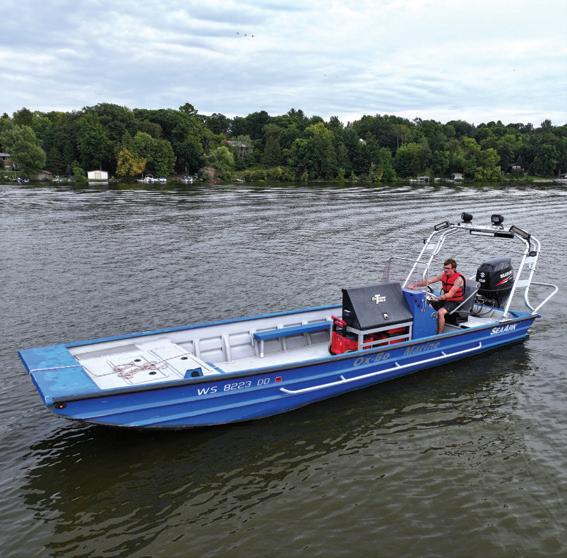


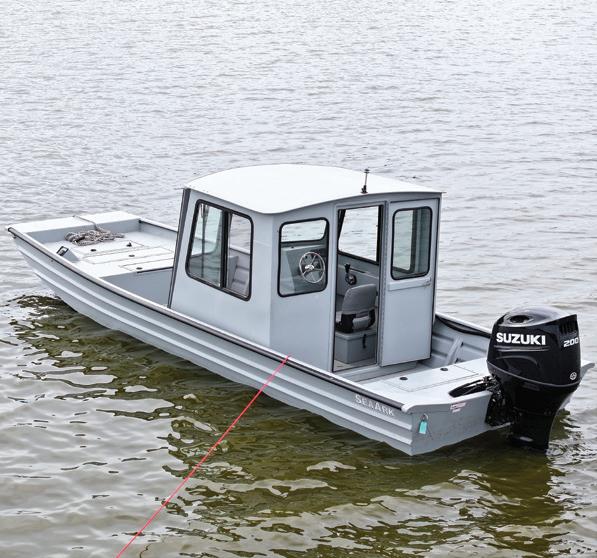
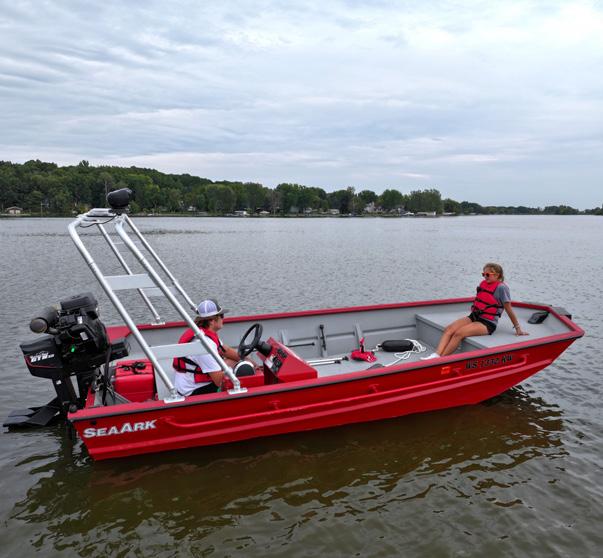


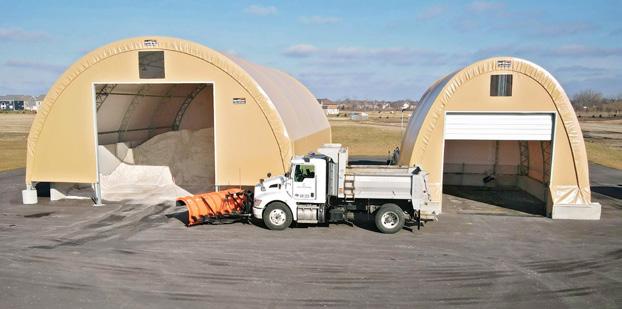



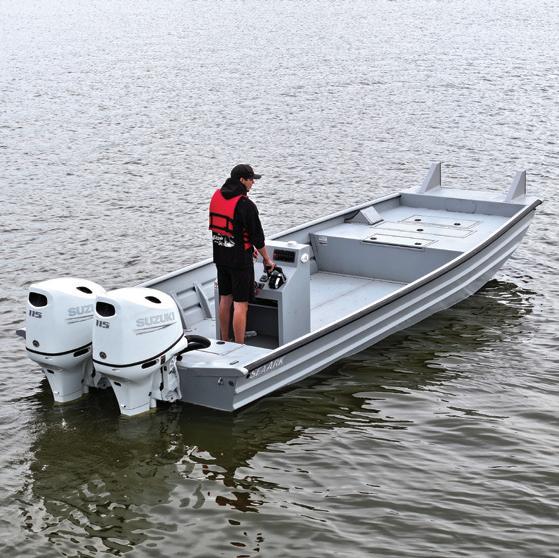





Residents want to feel safe in their homes and neighborhoods. Whether someone lives in the suburbs, downtown or in the country, a sense of personal safety and security has to be present if the community as a whole is going to thrive and grow.
As U.S. News and World Report noted recently, the crime rate can be a deciding factor in where individuals and families settle down. The magazine consulted recent FBI crime reports and reviewed the data for 859 U.S. cities, analyzing it to determine which cities’ murder and property crime rates per 100,000 people — were the lowest, and which ones were the highest.
According to the results, a Top 10 list of the Safest Places to Live in the U.S. in 2025-2026 was identified. The results are below.














The Vac•Con family of hydro excavators are designed for powerful, effective, and safe operation — no matter how tough the job.
Contractors and municipalities alike will discover that the X•Cavator family of products by Vac•Con are built to exceed their demands.
Talk to your local dealer today to see why countless customers trust Vac•Con to help get their jobs done.
Learn more at www.vac-con.com

